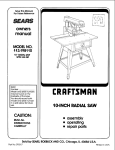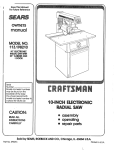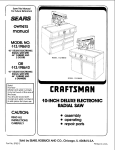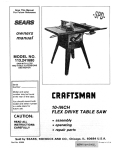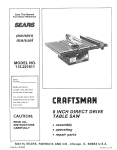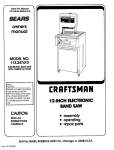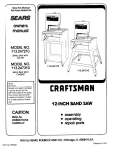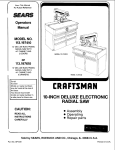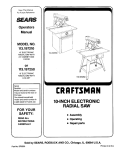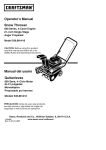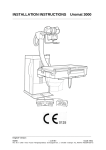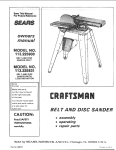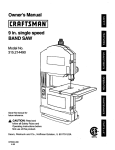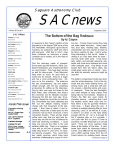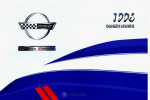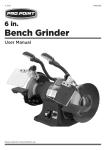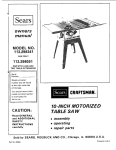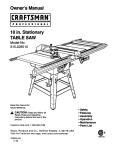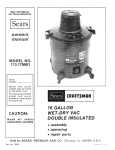Download Craftsman 113.198310 Owner`s manual
Transcript
f Save This Manual For Future Reference owners manual MODEL NO. 413.198340 \\ 10" RADIALSAW WITH44" CABINET \ Serial Number Model and serial numbers £RRFTgMRN may be found on the backside of the bas_. You should record both model and serial number in a safe place for future IO-INCH RADIAL SAW Use, CAUTION: • assembly • operating • repair parts READALL INSTRUCTIONS CAREFULLY _,. j k.. Sold by SEARS,ROEBUCKAND CO., Chicago, Part No. SP5015 _J IL.60684 U.S.A. Printed in U.S.A FULL If within one year from ONE YEAR WARRANTY the date ol purchase, this ON CRAFTSMAN Craftsman Radial RADIAL Saw tails due SAW to a defect in material or workmanship, Sears will repair it, free of charge. WARRANTY SERVICE CENTER/DEPARTMENT IS AVAILABLE THROUGHOUT This warranty applies only while This warranty gives you specific SEARS, GENERAL this product legal ROEBUCK SAFETY BY SIMPLY CONTACTING THE rights AND UNITED is used in the United States. and you may also have CO., DEPT. 698/731A 13. 14. 15. 16. 17. 18. 19. 20. 21. 22. other Sears INSTRUCTIONS 1. KNOW YOUR POWER TOOL Read and understand the owner's manual and labels affixed to the tool. Learn its application and limitations as well as the specific potential hazards peculiar to this tool. 2. GROUND ALL TOOLS This tool is equipped with an approved 3-conductor cord and a 3-prong grounding type plug to fit the proper grounding type receptacle. The green conductor in the cord is the grounding wire. Never connect the green wire to a live terminal. 3. KEEP GUARDS IN PLACE, in working order, and in proper adjustment and alignment. 4. REMOVE ADJUSTING KEYS AND WRENCHES Form habit of checking to see that keys and adjusting wrenches are removed from tool before turning it on. 5. KEEP WORK AREA CLEAN Cluttered areas and benches invite accidents. Floor must not be slippery due to wax or sawdust. 6. AVOID DANGEROUS ENVIRONMENT Don't use power tools in damp or wet locations or expose them to rain. Keep work area well lighted. Provide adequate surrounding work space. 7. KEEP CHILDREN AWAY All visitors should be kept a safe distance from work area. 8. MAKE WORKSHOP CHILD-PROOF -- with padlocks, master switches, or by removing starter keys. 9. DON'T FORCE TOOL It will do the job better and safer at the rate for which it was designed. 10. USE RIGHT TOOL Don't force tool or attachment to do a job it was not designed for. 11. WEAR PROPER APPAREL Do not wear loose clothing, gloves, neckties or jewelry (rings, wrist watches) to get caught in moving parts. Nonslip footwear is recommended. Wear protective hair covering to contain long hair. Roll long sleeves above the elbow. 12. USE SAFETY GOGGLES (Head Protection) Wear Safety goggles (must comply with ANSI Z87.1) at all times. Everyday eyeglasses only have impact resistant lenses, they are NOT THE NEAREST SEARS SERVICE STATES. rights Tower, which Chicago, vary from state to state. IL 60684 FOR POWER TOOLS safety glasses. Also, use face or dust mask if cutting operation is dusty, and ear protectors (plugs or muffs) during extended periods of operation. SECURE WORK Use clamps or a vise to hold work when practical. It's safer than using your hand, frees both hands to operate tool. DON'T OVERREACH Keep proper footing and balance at all times. MAINTAIN TOOLS WITH CARE Keep tools sharp and clean for best and safest performances. Follow instructions for lubricating and changing accessories. DISCONNECT TOOLS before servicing; when changing accessories such as blades, bits, cutters, etc. AVOID ACCIDENTAL STARTING Make sure switch is in "OFF" position before plugging in. USE RECOMMENDED ACCESSORIES Consult the owner's manual for recommended accessories. Follow the instructions that accompany the accessories. The use of improper accessories may cause hazards. NEVER STAND ON TOOL Serious injury could occur if the tool is tipped or if the cutting tool is accidentally contacted. Do not store materials above or near the tool such that it is necessary to stand on the tool to reach them. CHECK DAMAGED PARTS Before further use of the tool, a guard or other part that is damaged should be carefully checked to ensure that it will operate properly and perform its intended function. Check for alignment of moving parts, binding of moving parts, breakage of parts, mounting, and any other conditions that may effect its operation. A guard or other part that id damaged should be properly repaired or replaced. DIRECTION OF FEED Feed work into a blade or cutter against the direction of rotation of the blade or cutter only. NEVER LEAVE TOOL RUNNING UNATTENDED Turn power off. Don't leave tool until it comes to a complete stop. additional instructions t'- for radial arm saws GO..,--, BEFORE USING THE r-. SAW: WARNING: TO AVOID MISTAKES THAT COULD RESULT IN SERIOUS, PERMANENT INJURY, DO NOT CONNECT POWER CORD UNTIL THE FOLLOWING STEPS HAVE BEEN SATISFACTORILY COMPLETED: 1. Assembly and alignment. (See pages 9-22) 2. Examination and operating familiarity with ONOFF switch, elevation hand wheel, swivel lock, bevel lock and rip lock, guard clamp screw, spreader and anti-kickback device and miter lock. (See pages 23-26) 3. Review and understanding of all safety instructions and operating procedures throughout the manual. Read the following danger labels which appear on the front of the radial arm saw base assembly, motor and saw guard: _ W.E_ _PP_NG expected contact with the workpiece, table or part of your body. BEFORE EACH fence, USE Plan your work. -- To avoid injury from accidental starting, always remove the plug from the outlet, turn the switch off and remove the switch key before removing the guard, changing the cutting tool, changing the setup or making adjustments. -- To avoid injury from blade contact, slips, shocks, thrown pieces, etc., check the saw to make sure that no parts are missing or broken, bent, or have failed in any way, or any electrical component fails to perform properly. Shut off power switch, pull the plug from the outlet and replace damaged, missing and/or failed parts before resuming operation. -- To avoid injury from electrical shock, make sure your fingers do not contact the terminals when installing or removing the plug to or from a live outlet. ....._o°_,,_ _..... _,o_........ Know 1 this _e_ s_w, look end _n BII Und_r_l_nd Owners Msnu_ wBr_I_gS _nd _nd with Instruc_lons r_ommended on acted- sor,e_ 2 Properly tool guard Ihe cunJn __ ' _r,,..,,*_.-_v WHEN SAW INSTALLING __.._ OR 1. To avoid injury from unexpected lock the rip lock handle before 2. To avoid injury from (a) Bolt the saw walk, or slide unexpected 9 3 Provide s_pporl pro13er 4 Position the workplec'e cuffing tOOl ,rig Ihe arm _o Ihe left an_ c_mpmg Ihe yo_e so t_s hal:_l _aces the lence: or construct en auKl_ar_ lence per Owner $ ManuBI the re.co mo_5 beh,nd With power otf thebygwltch key removed¸ turn cuttin 9 t_ by hana Io mike sure ,_ does not slr_ke guar_t f_nce or any other S_W MOVING THE carriage travel, moving the saw. saw movement: to the floor if it tends to slip, during normal operation. (b) When table extensions over 24" wide are added to either side of the saw, make sure you either bolt the saw to the floor or support the outer end of the extension from the floor as appropriate. 3. To avoid injury from unexpected carriage travel adjust leveling feet so the arm tilts slightly downward to the rear so that the carriage will not roll forward due to gravity. Forward drift of the carriage on an improperly leveled saw could cause the blade to lunge forward due to un- -- Check the fence for proper workpiece support. To avoid fence breakage which could result in thrown workpieces and blade contact, do not use fences made of particle board or other composite materials - use 3/4" thick lumber long enough to extend in one piece from end to end of the saw table, and tall enough to be at least even with the top of the workpiece. Replace any fence where existing slots in the fence have weakened the fence or can snag the workpiece during ripping operations. Always check table locks to make su re any new fence is held secu rely(see page 18). --Choose your cutting tool carefully. Many saw accidents are caused by use of the wrong type blade, dull, badly set, improperly sharpened cutting tools, gum or resin adhering to the cutting tools, and by blade misalignment with the saw fence. Such conditions can cause the material to stick, jam (stall the saw), throw workpiece at the operator. or "kickback" the -- To avoid cutting tool failure and thrown shrapnel (broken pieces of blade), use only blades or other cutting tools marked for operating speeds 3450 rpm or higher. Never use a cutting tool larger in diameter than the diameter for which the saw was designed. --q-o avoid jamming of the blade, thrown workpieces, and damage to the blade collars, never use a broken, warped, or unbalanced blade. Do not overtighten arbor nut. Use arbor wrenches to "snug" it securely. -- To avoid injury from accidental blade contact by the workpiece or the operator do not perform layout, assembly, or setup work on the table while the cuttingtool is rotating. The rotating tool could cut and throw anything hitting the blade causingthe saw to unexpectedlycome forward. -- Usetherightguard.Toavoidlosingcontrolofthe workpiece,hittingthecuttingtool,or beingstruck bythrownpieces,neverdoanycuttingunlessthe properguard(withallitspartsin place)isinstalled andadjustedproperly. -- To avoid injuryfromthrown pieces,slips,blade contact,or jammingof theworkpiece,makesure no playexists betweenthe columnandcolumn supportor in thecarriageandthatthearm,yoke, bevellocks/clampsaretight. --To avoid injury from thrown objects,slips or jammingofthebladedueto pinchingoftheblade by shiftingboards: (a) Donotleavealongboardunsupportedsothe springof the boardcausesit to twist or rise fromthe table. (b) Checkto be surethat pieceswill not fall off the tableoncethey havebeencut. (c) Providesupportfor the workpiece,basedon its size and the type of operation to be performed. (d) Neveruseanotherpersonasasubstitutefora tableextension,or as an additionalsupport for a workpieceto assistin feeding,supporting,or pullingthe workpiece. (e) Nevercut workpiecesplacedsideto sideor stackedontop of eachother.Thepiecescan slideoneachother. WEARYOUR --The operationof any power tool can result in foreignobjectsbeingthrownintotheeyes,which canresultinpermanenteyedamage.Alwayswear safetygogglescomplyingwithANSIZ87.1(shown on package).Safety gogglesare availableat Searsretail catalog stores.Use of gogglesor glassesnot in compliancewithANSIZ87.1could resultin severeinjury from breakageof the eye protection. -- To avoid injury from uncontrollablereactionor thrownobjects,neverturn the saw"ON" before clearingthe tableor work surfaceof all objects (tools,scrapsof wood,etc.)exceptthe properly supportedworkpieceandrelatedfeedor support devicesfor the operationplanned. WHENEVER -- THE SAW IS RUNNING Always keep alert. Do not allow familiarity (gained from frequent use of your saw) to cause a careless mistake. Always remember that a careless fraction of a second injury. is sufficient to inflict severe, permanent If your saw makes an unfamiliar noise or if it vibrates excessively, stop the operation immediately. Do not restart until the source has been located and the problem corrected. Do not cycle the motor switch "ON" and "OFF" rapidly, as this might cause the sawblade to loosen, tn the event this should ever occur, turn the switch off, allow the sawblade to come to a complete stop, and remove the switch key. To avoid damage to the blade and flange, retighten the arbor nut normally, not excessively. -- Never perform any operation freehand. Injury can occur from blade contact or thrown pieces when the workpiece is torn from the hands. "Freehand" means feeding the sawblade into a workpiece or feeding the workpiece into the sawblade or other cutting tool without using the fence or some other proper device to prevent the workpiece from twisting and binding on the cutting tool during the cutting operation. -- To avoid accidental blade contact, avoid awkward hand positions where a sudden slip causes a hand to move toward the sawblade or other cutting tool. Do not place fingers or hand on the workpiece or table that is in the path of the sawblade. -- To avoid being pulled into the back of the blade before you can let go or react, never reach in back of, or around the cutting tool, with either hand to hold down the workpiece or for any reason. -- To avoid injury from unexpected starting, never attempt to free a stalled sawblade without first turning the saw "OFF" and removing the switch key. If the sawblade is stalled or jammed, shut the saw "OFF", remove the switch key, remove the workpiece, check for looseness in clamps, arm and carriage, check the sawblade squareness to the table surface and to the fence, and check for heel (see page 20). Adjust as indicated. -- To avoid injury from falling parts or from falling into the saw, never climb on or near the saw when its power is "ON". Never leave the saw area when power is "ON", or before the cutting tool has come to a complete stop. -- To avoid unauthorized saw use, remove the switch key and put the key away before leaving the saw area. BEFORE STARTING A RIPPING TYPE CUT To avoid injury from being struck by a thrown workpiece, position the saw so neither you, a helper, or a casual observer is forced to stand in line with the sawblade or workpiece. Whenever possible, use the "in-rip" position. (See page 31.) This provides maximum clearance for feeding by hand, push stick, or push block as appropriate. To avoid thrown workpieces or being pulled into the saw before you can react, push the workpiece fromthenoseside(oppositethesawdustexhaust chute) of the guard. Note the warningon the guard. -- Toavoidinjuryfromthrownpieces,slips,orjams, theworkpiecemustbehelddownonthetableand againstthefence.Planyour handplacementsto safelyfeedthe workpieceinto the cutting tool. Featherboards canalsohelpkeeptheworkagainst thefence.Afeatherboardis madeof solidhJmher persketch. -:__-_J -- Toavoidaccidentalbladecontact,neverposition the guard or anti-kickbackassemblywith the power"ON" or the bladespinning. -- Whenproperlyadjustedto just clearthe workpiece,theguardnosewill helpkeeptheworkpiece down on the table. To preventinjury from the workpiecerising from the table, thrown chips from the workpieceor blade,or hand slippage towardsthefront of the blade,positionthe nose guardto just cleartheworkpiece.(Seepage26). -- To maximizeprotectionfromthe rearoftheblade andavoidinjuryfrom kickbacks,adjustthe antikickback and spreaderdevices as instructed. (Seepage22& 26.) -- Toavoidinjuryfromkickback,makesurebytrial before starting the cut that the anti-kickback pawlswill stopthe kickbackonceit hasstarted. Makesurepointsof pawlsaresharp.(Seepage 26.)Warning:Useextra care for non-thru cuts becausethe anti-kickbackpawlscannotalways grabtheirregularsurfacecreatedbytheoperation. INSPECT YOUR WORKPIECE -- To keep the sawblade from rising up on workpiece and throwing it back at the when sawing 1/4" or thinner materials, normal ripping procedures except set into the table top at least 1/8". top of the operator, follow all sawblade -- To avoid kickback, use extra care when ripping wood that has a twisted grain or is twisted or bowed - it may rock on the table and/or pinch the sawblade. If the workpiece cannot be made stable against the fence and table top, do not cut it with a radial arm saw. -- To avoid blade contact and/or kickback, use a push stick when ripping short (10 to 12 inches long) or narrow (2 to 6-1/2 inches wide) workpieces. Usea push block as illustrated on page 30 for pieces 3/8 to 2 inches wide or, wherever possible, place the wider section of the board between the fence and the blade. --To avoid kickbacks never feed a workpiece through the saw with another piece (butting second piece against trailing end of piece cut) even if of the same thickness, being -- To keep control of your workpiece, shorter than the blade diameter. never rip work -- For rip or rip-type cuts, the trailing end of the workpiece to which a push stick or push board is applied must be square (perpendicular to the fence and table top) so that feed pressure applied to the workpiece by the push stick or push block will not cause the workpiece to come away from the fence or rise from the table and possibly cause a kickback. --Plastic and composition (like particle board) materials may be cut on your saw. However, since these are often quite hard and slippery, the antikickback pawls may not stop a kickback. To get best performance, rip with the finished side down (next to the table) and the roughest side up, and be especially attentive to follow proper set up and cutting procedures. WHILE DOING A RIP TYPE OPERATION -- Never reach around the blade to the to touch the portion of workpiece blade until the whole workpiece has beyond and clear of the blade. Your cause a kickback which could strike pull your hand into the rear (outfeed blade before you can let go or react. outfeed side beyond the been pushed touch could someone or side) of the -- Position your body at the nose (in-feed) side of the guard. Start and complete the cut from that same side. This will require added table support for long or wide workpieces that extend beyond the length or width of the saw table to prevent workpiece from being thrown as it falls from the table. -- Never apply the feed force to the section of the workpiece that will become the cutoff (free) piece. Feed force when ripping must always be applied between the sawblade and the fence so that the slot cut by the blade (kerf) will not be pinched shut on the blade causing a kickback. Never touch the piece that has been cut off until the blade has come to a complete stop. --Keep pushing the section of the workp_ece between the blade and the fence until the piece has been pushed completely past the blade, so the blade will not grab the piece and throw it back at the operator. BEFORE DOING A CROSSCUT TYPE CUT --To avoid blade contact, do not perform any operation that requires the cutting tool to extend beyond the edges of the table used for supporting the workpiece. --To maximize protection from accidental blade contact and reduce risk of jamming objects into the guard, place guard in a horizontal position and adjust anti-kickback pawls to just clear the top of the fence or the workpiece, whichever is higher. The anti-kickback pawl assembly will __"_---_.,... --_ = oo +-, -- provideadditionalguardingfromcontactwiththe front of the blade. --To preventthe cutting tool from grabbingthe table or workpieceand beingpropelledtoward you, neverlowera revolvingcuttingtool into the tableor a workpiecewithoutfirst lockingthe rip lockhandleandclampingtheworkpiecein place. Releasethe handle only after having firmly graspedthe carriagehandle. -- Toavoidbladecontactor injuryfromathrowncut off piece,neverusea lengthstop on the cut off endoredgeoftheworkpiece.Neverhangontoor touchthe cutoff pieceoftheworkpiecewhilethe poweris"ON"and/orthesawbladeisrotating.To preventpinchingthatcouldcausethe pieceto be thrown,thecut off piecemustneverbeconfined, pushed,or grabbedwhilethebladeis spinning. INSPECT YOUR WORKPIECE --To avoid injury from thrown objects, slips or jamming of the blade, make sure the workpiece will fit the supports (fence, table, fixtures or jigs) so it will not twist, rock or otherwise bind on the cutting tool. Make sure there is no sawdust or other foreign material between theworkpieceand its support. WHILE DOING --Always position A CROSSCUT start with the carriage behind the fence before TYPE CUT in the turning full rear the saw on. -- Never push the carriage and blade backwards into the work to do a crosscutting type operation. The cutting tool can throw the work over the fence, striking someone or causing you to fall into the blade. --Always return the carriage to the full rearward position behind the fence at the completion of each crosscut type operation. Never remove your hand from the yoke handle unless the carriage is in this position. Otherwise, the cutting tool may climb up on the workpiece and be propelled toward you. BEFORE USING ACCESSORIES To avoid injury from unanticipated hazards, use only recommended accessories as listed on page 43. The use of grinding wheels, abrasive or cut off wheels, or wire wheels, can be dangerous and are not recommended. Such devices can break explosively injury. and throw shrapnel, causing severe Thesawblade, dado, orothercutting tool must be removed from the saw arbor before using the accessory shaft. Never operate the saw with cutting tools (including sanding accessories or buffing) installed on both ends of the sawarborto avoid being pulled into moving parts by hair, threads, clothing, etc. Make sure the unused arbor is always covered by a guard, the arm, or the screw cap. Using a drill chuck. To avoid injury from sudden bending or breaking of a drill bit, do not install or use twist drills longer than 7" in length or extending more than 6" beyond the chuck jaws. Do not install or use any reduced shank drill except the spade type (!" diameter or smaller). Use for drilling wood or plastic only - bit speed cannot be properly adjusted for other materials. Do not use twist drills larger than 1/2" in diameter. glossary of terms for woodworking Anti-Kickback Pawls (AKB) Device which, when properly adjusted, is designed to stop the workpiece from being kicked back at the operator during ripping operations. See illustrations on pages 22 & 26. Arbor The shaft on which a cutting tool is mounted. Crosscut A cutting or shaping operation made across the width of the workpiece. See illustrations on pages 28 & 29. Dado A non-through cut which produces a square sided notch or trough in theworkpiece. Featherboard A device which can assist during rip type operations. in guiding workpieces Freehand Performing a cut without the use of fence (guide), hold down or other proper device to prevent the workpiece from twisting during the cutting operation. Twisting of the workpiece can cause it to be thrown or kicked back by a radial saw. 6 Gum A sticky, sap based residue from wood products. Heel Misalignment of the blade. See page 20 & 21. In-Rip Positioning the blade parallel to the fence with the motor toward the front of the saw. See illustration on page 31. Kerf The amount through cut non-through of material removed or the slot produced or partial cut. by the blade by the blade in a in a Kickback An uncontrolled grabbing and throwing of the workpiece back toward the operator during a rip type operation. Leading End The end of the workpiece operation, is pushed into which, during the cutting tool a rip type first. Molding A non-through cut which produces a special shape in the workpiece used for joining or decoration. Outrip Positioning the blade parallel to the fence with the motor toward the rear of the saw producing maximum ripping capacity. See illustration on page 31. Push Stick A device used to feed the workpiece through the saw during narrow ripping type operations so the operator's hands are kept well away from the blade. See page 30. Push Block A device used for ripping type operations too narrow to allow use of a push stick. See page 30. Rabbet A notch in the edge of a workpiece. Resin A sticky, sap base substance that has hardened. Ripping A cutting piece. operation along the length of the work- Revolutions Per Minute (RPM) The number of turns completed by a spinning in one minute. object Sawblade Path The area of the workpiece or table top directly in line with either the travel of the blade or the part of the workpiece which will be, or has been, cut by the blade. Set The distance that the tip of the sawblade bent (or set) outward Throw-Back Throwing kickback. of small from tooth is _ pieces in a manner similar to a Thru-Sawing Any cutting operation where the blade extends completely through the thickness of the workpiece. Trailing End The workpiece end last cut by the blade in a ripping operation. Workpiece The item on which the cutting operation is being performed. The surfaces of a workpiece are commonly referred to as faces, ends, and edges. electrical connections POWER SUPPLY If you are not sure that your outlet grounded, have it checked by a qualified 1. Motor Specifications The A-C motor non-reversible tions: used in this saw is a capacitor-start, type having the following specifica- Rated H.P .................................... Maximum Developed H.P ..................... Voltage ..................................... Amperes .................................... Hertz (cycles) ................................ Phase .................................... RPM ...................................... Rotation of Blade Arbor ............... 1.5 2.5 120 11 60 Single 3450 Clockwise WARNING: TO AVOID ELECTRICAL HAZARDS, FIRE HAZARDS, OR DAMAGE TO THE TOOL, USE PROPER CIRCUIT PROTECTION. YOUR SAW IS WIRED ATTHE FACTORY FOR 120V OPERATION. CONNECT TO A 120V, 15-AMP, BRANCH CIRCUIT AND USE A 15-AMP, TIME DELAY FUSE OR CIRCUIT BREAKER. IF NOT PROPERLY GROUNDED THIS POWER TOOL CAN CAUSE ELECTRICAL SHOCK PARTICULARLY WHEN USED IN DAMP LOCATIONS IN PROXIMITY TO PLUMBING. IF AN ELECTRICAL SHOCK OCCURS THERE IS ALSO THE POTENTIAL OF A SECONDARY HAZARD SUCH AS YOUR HANDS CONTACTING THE SAWBLADE. NOT ALL OUTLETS ARE PROPERLY GROUNDED. TO AVOID SHOCK OR FIRE, IF POWER CORD IS WORN OR CUT, OR DAMAGED IN ANY WAY, HAVE IT REPLACED IMMEDIATELY. =o the face of the blade. If your unit is for use on tess than plug that looks like below. is properly electrician. 150 volts 3-PRONG it has a PLUG PROPERLY GROUNDED OUTLET GROUNDING PRONG This power tool is equipped with a 3-conductor cord and grounding type plug which has a grounding prong, listed by Underwriters' Laboratories. The ground conductor has a green jacket and is attached to the tool housing at one end and to the ground prong in the attachment plug at the other end. This plug requires a mating type outlet as shown above. 3-conductor grounded WARNING: TO MAINTAIN PROPER TOOL GROUNDING WHENEVER THE OUTLET YOU ARE PLANNING TO USE FOR THIS POWER TOOL IS OF THE TWO PRONG TYPE, DO NOT REMOVE OR ALTER THE GROUNDING PRONG IN ANY MANNER. USE AN ADAPTER AS SHOWN AND ALWAYS CONNECT THE GROUNDING PRONG TO KNOWN GROUND. _ =_ "' == It is recommendedthatyouhavea qualifiedelectrician replacethe two prong outlet with a properly groundedthreeprongoutlet. An adapterasshownbelowisavailableforconnectingplug to 2-prongreceptacles.Thegreengrounding leadextendingfrom the adaptermustbeconnectedtoa permanentgroundsuchasto a properly groundedoutletbox. GROUNDING 3-PRONG PLUG \_-; LUG / MAKE _ ._ t_[i..T_,_F _._ L SURE KNOWN THIS IS GROUND _ONNECTED TO A -PRONG RECEPTACLE WARNING: THE ADAPTER ILLUSTRATED IS FOR USE ONLY IF YOU ALREADY HAVE A PROPERLY GROUNDED 2-PRONG RECEPTACLE, MOTOR SAFETY PROTECTION CAUTION: TO AVOID MOTOR DAMAGE THIS MOTOR SHOULD BE BLOWN OUTOR VACUUMED FREQUENTLY TO PREVENT SAWDUST BUILDUP WHICH WILL INTERFERE WITH NORMAL MOTOR VENTILATION. 1. This tool should be connected toa 120V, 15Amp branch circuit with a 15 Amp time delay fuse or circuit breaker. Failure to use the proper size fuse can result in damage to the motor. 2. If the motor fails to start, turn the power switch to the "OFF" position immediately. UNPLUG THE TOOL. Check the saw blade to insure that it turns freely and that its teeth are not wedged into the table top. After the blade has been freed, try to start the motor again. If, at this point, the motor still fails to start, refer to the "Motor TroubleShooting Chart." 3. If the motor should suddenly stall while cutting wood, the power switch should be turned off, the tool unplugged and the blade freed from the wood. The motor may now be restarted and the cut finished. 8 4. Frequent breakers "blowing" of fu£e£ or tripping may result if: of circuit (a) MOTOR IS OVERLOADED - Overloading can occur if you feed too rapidly or if saw is misaligned so that the blade heels (pg. 19,20). (b) MOTOR CIRCUIT tS FUSED DIFFERENTLY FROM RECOMMENDATIONS - Always follow instructions for the proper fuse/breaker. Do not use a fuse/breaker of greater capacity without consulting a qualified electrician. (c) LOW VOLTAGE - Although the motor is designed for operation on the voltage and frequency specified on motor nameplate, normal loads will be handled safely on voltages not more than 10% above or below the nameplate voltage. Heavy loads, however, require that voltage at motor terminals equals the voltage specified on nameplate. 5. Most motor troubles may be traced to loose or incorrect connections, overloading, reduced input voltage (such as small size wire in the supply circuit) or to overly long supply circuit wire. Always check the connections, the load and the supply circuit whenever motor fails to perform satisfactorily. Check wire sizes and length with the Wire Size Chart below. WIRE SIZES The use of any extension cord will cause some loss of power. To keep this to a minimum and to prevent over-heating and motor burn-out, use the table below to determine the minimum wire size (A.W.G_) extension cord. Use only 3 wire extension cords which have 3 prong grounding type plugs and 3-pole receptacles which accept the tools plug. CAUTION: For circuits that are farther away from electrical service box, the wire size must be increased proportionately in order to deliver ample voltage to the saw motor. Length of the Conductor Wire 240V 0 - 50 Feet 50 - 100 Feet Over 100 Feet Sizes Required (American Wire Gage Number) Lines 120V Lines No. 16 [ No. 14 No. 14 No. 12 / ] No. 12 No. 8 contents Page Page Guarantee .................................... General Safety Instructions for Power Tools .... Additional Safety Instructions for Radial Saws .. Glossary of Terms for Woodworking ........... Electrical Connections ........................ Assembly and Alignment ..................... Unpacking and Preassembly ................ Alignment Procedure ....................... 2 2 3 6 7 9 10 16 Location and Function of Controls ............ Basic Saw Operations ........................ Adjustments to Compensate for Wear ......... Trouble Shooting ............................ Maintenance and Lubrication ................. Recommended Accessories ................... 23 27 33 37 42 43 Repair Parts ................................. 44 =E_ E_ assembly TOOLS and alignment FRAMING NEEDED SQUARE MUST BE TRUE. Check its accuracy as illustrated below. MEDIUM CHECKING INSIDE SCREWDRIVER ACCURACY OF SQUARE OF REAR EDGE OF FRONT 7/16" WRENCH #2 PHILLIPS SCREWDRIVER _:_ 1/2" WRENCH 3/4" DRAW (FENCE, SPACER AND BOARDS REMOVED) LIGHT LINE ON _ TABLE ALONG THIS EDG_E _ CHECKING OUTSIDE ACCURACY OF SQUARE OF TABLE BACK _ u I I _ = FENCE / / DRAW _/_TABLE = LIGHT I LINE ALONG THIS WRENCH q rill L I _hL _!_ _', L_t _ID Li:_L:ii",i!:..!:..'...: !i., i !' i.__ 3/4" SOCKET 9/16" SOCKET 7/16" SOCKET FRAMING SQUARE PENCIL SOCKET EXTENSION SOCKET WRENCH 1/8" HEX "L" WRENCH 3/16" HEX "L" WRENCH SHOULD OVERLAP BE NO HERE SQUARE IS IN DOTTED Ut_J GAP OR WHEN FLIPPED POSITION OVER SHOULD OVERLAP BE NO HERE GAP OR WHEN SQUARE IS FLIPPED IN DOTTED POSITION OVER ON EDGE unpacking and preassembly WARNING: TO AVOID INJURY FROM UNEXPECTED STARTING OR ELECTRICAL SHOCK, DO NOT PLUG THE POWER CORD INTO A SOURCE OF POWER UNTIL ALL ASSEMBLY AND ALIGNMENT STEPS ARE COMPLETE. THIS CORD MUST REMAIN UNPLUGGED WHENEVER YOU ARE WORKING ON THE SAW. Model 113.198310 Radial Saw is shipped in one box. 1. Unpacking and Checking complete Contents (a) Separate all "loose parts from packaging materials and check each item with "Table of Loose Parts" to make sure all items are accounted for, before discarding any packing material. Item Description M Bag of Loose Parts #507495 ............ Containing the Following Items: A Foot Leveling .................... B Nut Hex Jam 1/2-13 .............. C Screw, Truss Hd. 1/4-20 x 1/2 ..... D Lockwasher Ext. 1/4 .............. E Nut Hex 1/4-20 ................... F Screw, Pan Hd. Ty "BT" 1/4 x 1/2 ................ G Screw, Pan Hd. Ty B #10 x 1 ....... ®° WARNING: IF ANY PARTS ARE MISSING, DO NOT ATTEMPT TO ASSEMBLE RADIAL ARM SAW, PLUG IN THE POWER CORD, OR TURN THE SWITCH ON UNTIL THE MISSING PARTS ARE OBTAINED AND ARE INSTALLED CORRECTLY. LOOSE PARTS LIST FOR MODEL 113.198310 Item A B C D E F G H I J K L Description Qty. 4 8 48 48 48 8 6 @ ° @ F 1 G Qty. Basic Saw Assembly ................... Owners Manual ....................... Fence, Rip ............................ Table, Rear ........................... Table, Spacer ......................... Cap Trim, L.H ......................... Cabinet Asse'mbly ..................... Handwheel Assembly .................. Trim Ledge ........................... Cap Trim, R.H ......................... Arbor Wrench ......................... Shaft Wrench ......................... 1 1 1 1 1 1 1 1 1 1 1 1 N Bag of Loose Parts #50749._.Z7 ............ Containing the Following Items: A Pad Guard ....................... B Indicator Rip ..................... C Indicator Bevel ................... D Cap Motor Support ............... E Plug Plastic ...................... F Screw Pan Hd. 10-32 x 1/2 ........ G Lockwasher Ext. #10 .............. H Cover ............................ I Switch Key ....................... 1 1 2 1 1 4 1 1 2 1 A N M / D E E G F I NOTE: Loose Parts Bag and Assembly Numbers refer to three digits, underlined in example below, or the I.D. Number printed on each bag or carton. X04507488H000 lO 44" CABINET ASSEMBLY FOR MODEL NO. 113.198310 4. Place the under support on the shelf. Locate two (2) 1/4-20 x 1/2 truss head bolts, Iockwashers and hex nuts from loose parts bag #495. Attach the supports to the shelf in holes as illustrated and tighten nuts with 7/16" wrench or socket. ASSEMBLE CABINET BEFORE MOUNTING SAW 1. Separate all "loose" parts from packing materials and check each item with "Parts List" to make su re all items are accounted for before discarding any packing material. 44" CABINET ASSEMBLY MODEL NO. 113.198310 A B C D E F G H FOR Right Side Panel ......................... Left Side Panel ........................... Lower Shelf .............................. Under Support ........................... Skirt ..................................... Shelf Stiffener ........................... Corner Brackets ......................... Spacer .................................. Shelf Stiffener Rear ...................... e== 1 1 1 1 2 1 4 2 1 5. Assemble the under support to the lower shelf with four (4) 1/4-20 x 1/2 truss head bolts, Iockwashers and hex nuts. Tighten securely with 7/16" wrench or socket. ! A WARNING: IF ANY PARTS ARE MISSING, DO NOT ATTEMPT TO ASSEMBLE RADIAL ARM SAW, PLUG IN THE POWER CORD, OR TURN THE SWITCH ON UNTIL THE MISSING PARTS ARE OBTAINED AND ARE INSTALLED CORRECTLY. 6. Attach the second support. Use two bolts, Iockwashers, under support with shelf stiffener to the under (2) 1/4-20 x 1/2 truss head and hex nuts to fasten to the 7/16" wrench or socket. 2. After layout of stand parts, take the bottom shelf and turn upside down on floor. Small front flange should be pointing upward. 3. Place one shelf stiffener shelf as shown. against front flange of 11 i" 7. Locate the four (4) corner brackets and use eight (8) 1/4-20 x 1/2 truss head bolts, Iockwashers and hex nuts to mount the corner brackets to the shelf AS ILLUSTRATED. Tighten the nuts with a 7/16" wrench or socket. 8. Locate the right and left side panels and eight (8) 1/4-20 x 1/2 truss head bolts, Iockwashers and hex nuts to attach side panels to shelf. Mount the bolts through the four holes as illustrated and tighten with 7/16 wrench or socket. To assemble, lay the side panel on its backside and stand th6 shelf up as illustrated. BOTTOM SIDE OF LOWER SHELF RIGHT SIDE PANEL 9. Locate the two (2) skirts and the eight (8) 1/4-20 x 1/2 truss head bolts, Iockwashers and hex nuts to attach them to the top of the side panels. Attach one to the front and one to the rear of the stand as illustrated and hand tighten nuts. 10. Secure rear of lower shelf to right side and left side panels using two (2) 1/4-20 x 1/2 truss head bolts, Iockwashers and hex nuts. Hand tighten nuts only at this time. 12 COVER / 11. Locate the right and left side spacers, the six (6) 1/4-20 x 1/2 truss head bolts, Iockwashers, and hex nuts. Position the spacer inside the right and left side panels and fasten in the three holes as illustrated. Hand tighten nuts. SPACER / _D © 12. Locate the two (2) covers and attach to openings in the right and left side panels as illustrated. \ SIDE PANEL I/4-20 x 1/2 E_ ¢D--- uo,_: CHECKING CABINET FOR SQUARENESS TOOLS NEEDED: Framing square, 3/4" and 7/16" wrench or socket. wrench 1. With cabinet on back side place a square on lower shelf next to right side panel. Adjust stand so both right side panel and lower shelf touch square (as illustrated). Then tighten nut holding rear of shelf to side panel and right side spacer to front of lower shelf. Repeat procedure for left side. 2. Place square at top side of cabinet and adjust stand so square touches both skirt and side panel (as illustrated). Then tighten right side of front and rear skirts to side panel. Repeat procedure for left side. 13 3. Locate four (4) leveling and eight (8) 1/2-13 hex nuts. Attach the leveling feet to bottom of side panels in front and rear as illustrated. Hand tighten hex nuts. WARNING: TO AVOID INJURY FROM UNEXPECTED SAW OR WORK MOVEMENT, LEVELING FEET MUST BE ADJUSTED SO THAT SAW DOES NOT ROCK. TO AVOID UNEXPECTED CARRIAGE MOVEMENT, ADJUST LEVELING FEET SO THAT THE ARM SLOPES SLIGHTLY DOWNWARD TO THE REAR. CABINET NUTS 4. To adjust leveling feet so the saw will set properly: a. Move saw to desired location. b. With 3/4" wrench loosen bottom LEVELING FOOT nut. c. Back off top nut by hand. d. Raise or lower foot by adjusting using 3/4" wrench. bottom nut e. Snug top nut against inside of leg by hand. f. Adjust all four feet as necessary, then tighten all four bottom nuts using a 3/4" wrench. MOUNTING SAW 1. From loose parts bag #495, find the following hardware: 8 - Truss Head Botts 1/4-20 x 1/2 8 - Lockwashers External 1/4 8 - Hex Nuts 1/4-20 SAW 2. Place saw on cabinet so that holes in bottom of saw line up with holes in top of cabinet. BASE _ 6 HEX NUT NOTE: It may be necessary to loosen the bolts holding the skirt to the side panel of the cabinet if the holes do not line up. Once mounting bolt is in place retighten cabinet bolts securely. TRIM CAPS & TRIM LEDGE 1. Locate the two (2) trim caps, the trim ledge, the six (6) type "B" #10x 1 screws and eight (8) type BT 1/4 x 1/2 screws. 2. Place the trim ledge against the bottom of the base using four (4) type"B" metal screws, secure the trim ledge to the base from below using a phillips screwdriver. 3. Then reach through the base from behind the front table board and secure the trim ledge with four (4) type "BT" screws using a phillips screwdriver. 14 e I ,',,, 3. Install bolts, Iockwashers, and nuts as shown. Tighten securely using a 7/16" wrench or socket. ATTACHING jl*° H TRIM LEDGE 4. Position the trim caps in place and hold in place with type B metal screw from the bottom side. 5. Then reach through the base from behind the front table board and secure the trim cap with two (2) type "BT" screws using a phillips screwdriver. Repeat procedure for other side. TRIM ATTACH ELEVATION CAF HANDWHEEL 1. From loose parts bag #497, find one (1) screw 10-32 x 1/2 and one (1) external Iockwasher. Install handwheel to front of base as illustrated. ELEVATION HANDWHEEL MOUNTING 1. Remove wrenches MOTOR the blade guard. Locate and remove the blade. the arbor CAUTION: Do not attempt to mount the motor until the blade guard and blade have been removed. 2. Elevate the arm approximately shipping pad. 3. Using a 3/4 socket remove 1/2" flat washer from motor 2 inches to remove 1/2-13 lock nut and pivot support. 4. Slide motor on motor pivot support until firmly seated on support as illustrated. motor 5. Re-install the flat washer tighten until snug with 3/4" nut WARNING: DO NOT OVER and lock socket. TIGHTEN is and LOCKNUT. To insure proper function of the bevel lock, move the bevel lock handle while tightening the Iocknut. Adjust according to Step 6. 6. Push bevel NOTE: lock handle Bevel lock handle to left side to lock. should left side of yoke when in locked lock handle is permitted to contact adjustment is required not contact extreme position. If bevel yoke the following a. Unlock bevel lock handle and tighten motor Iocknut. Recheck bevel lock handle position (see illustration). b. Repeat tighten adjustment if necessary or motor will not index. Do not over 15 ALIGNMENT PROCEDURE IMPORTANT: In order to obtain maximum cutting accuracy and safety, the following six steps must be carefully followed. Become thoroughly familiar with these steps so that you can always maintain your saw in proper alignment. The accuracy of each adjustment is always dependent upon the accuracy of the preceeding adjustment. Be sure to align the saw in the exact sequence described to insure proper alignment and cutting accuracy. After following the 6 step assembly and alignment procedure and the Basic Saw operation section refer to Trouble Shooting section if any difficulty is experienced when performing any sawing operation. STEP ONE Adjusting Column Tube in Column Support J 1. Elevate and then lower the arm. © (a) If the column binds and elevation is difficult, loosen the four (4) bolts, with 9/16 socket and extention, located through the holes in the rear column support cover until movement is smooth but firm. (b) If column moves front to rear within the column support, tighten the four (4) bolts, with a 9/16 socket and extension, located through holes in rear column support cover until movement disappears. Elevation should be smooth and firm. Recheck adjustments, repeat steps (a) and (b) if necessary. 2. Locate the four (4) plastic hole caps in loose parts bag #497. After all adjustments are made to the column support insert the plastic caps in all four holes in rear column support cover. STEP TWO o NOTE: The following adjustment, performed properly, will result in the work table being flat and parallel to the arm. This helps insure the blade will cut the same depth along the entire crosscut travel. LEVELING FRONT WORK E) ® TABLE 1. Loosen the three (3) leveling screws located in the center of the table with a 1/8" hex 'L' wrench. 2. Check the five (5) mounting screws they are snug. Do not over tighten. to make sure @ O i 3. Push the bevel lock handle to the right to release the motor. Index the motor with the saw blade end of the motor shaft down and lock bevel lock handle to the left. 4. Slide the carriage so the motor center of front table board. 5. Unlock position left. 16 the miter as shown, o -db lock handle and position shaft MITER is in the in the unindex the arm to the I LOCK 6. Lay the arbor wrench on the work table under the motor shaft. Carefully lower the arm with the elevation handle until the motor shaft is just touching the arbor wrench. The wrench should slide back and forth with only slight contact with motor shaft. NOTE: When moving the arm from the left side to the right it is necessary to move the motor along the arm to check the front table at several points from front to back. 7. Starting from the left side of the front table board, move the Radial Arm to the right checking the table with the arbor wrench to determine the lowest spot in the table. Once the lowest spot in the table is determined, you can begin to level the table. RADIAL ARM /% €,o € //\\ NOTE: For safety reasons, stops have been provided to prevent 360 ° rotation of the radial arm. 8. Position the arm over the lowest spot in the table and repeat Step 6. 45_ LEFT_ T 9. Tighten the mounting screws located at the high spots in the table with a Phillips screwdriver. Then recheck the entire table. Make sure center leveling hex screws are loose. NOTE: Do not change this elevation setting until the entire work table has been adjusted. 10. Lay the rear table board on edge across the front table to serve as a straightedge to determine whether the front table board is high or low at its center. 11. If the front table is high at center, first tighten the center hold down screw until table is level - then tighten the three (3) leveling screws until those screws are tight. If table is low at center, first loosen the center holddown screw, then tighten the three (3) leveling screws until table is level. Retighten the center holddown screw. Recheck table to make sure it is level. 12. Position the rip (guide) fence, spacer board and rear table board behind the front table board, and push front table lock handles down as shown. 13. Return motor to vertical position. 17 Adjusting tront table lock handles WARNING: TO AVOID SUDDEN SLIPPAGE, BREAKAGE, OR THROWING OF PARTS, FRONT TABLE BOARD LOCK HANDLE MUST LOCK TABLE BOARDS AND RIP FENCE SECURELY IN PLACE. 1. To adjust the table board clamps check by pulling up on rip fence. There should be enough pressure to keep the rip fence from pulling up. To adjust the pressure on the clamp: a. Lift front table lock handles pressure on boards. b. Loosen the two eccentric located at the rear of the 7/16" wrench or socket. up to release spacer clamps table top with a c. Rotate the spacer toward the rear table board. Tighten spacer with 7/16" wrench or socket. Repeat procedure for clamp on other side. / / d. Push down on front lock handles and recheck pressure by pulling up on rip fence. If rip fence is too loose, repeat adjustment. STEP THREE Squaring Crosscut Travel NOTE: This adjustment accurately travels square helps ensure the to the rip fence. blade SHAFT 1. Index arm at 0 ° miter and lock. 2. Install saw blade as shown. Motor shaft has left handed threads - turn nut counterclockwise to tighten. CAUTION: Do not overtighten arbor nut. Use arbor wrench to "snug" nut in place. Overtightening could distort the blade collars and cause blade to wobble. 3. Lower arm until saw blade just clears the front table. Be sure the miter lock handle and the bevel lock handle are locked. 4. Place a framing square on the table as shown and position the blade and square until the leg of the square just contacts a tooth of the blade. Mark this tooth with a pencil. NOTE: The framing (or combination) square must be "true" - see start of "Assembly and Alignment" section on page 10 for checking method. 5. When the carriage is moved back and forth on the arm, the marked tooth should just touch the square at all points. If marked tooth moves into square or away from square the following adjustments are required. (a) Loosen the four (4) 1/4-20 socket set screws on both sides of the front column support (2 on each side) with a 1/8" Hex "L" wrench as illustrated on next page. 18 (b) Move the arm in the proper direction to make marked tooth follow edge of square when the saw blade is moved along arm in a "crosscut" manner. _,,. BEVEL LOCK _""--. HANDLE _ \ (c) Carefully retighten upper two (2) 1/4-20 socket set screws alternating from left side to right side so as not to force arm out of adjustment, FOUR HEAD (d) Recheck blade travel. Adjust arm position as needed by readjusting upper screws only. SOCKET SCREWs (e) Once arm position is good, tighten lower 1/420 socket set screws. Do not overtighten. Check elevating handwheel for ease of rotation. If rotating handwheel is difficult, readjust socket set screw tightness as needed. NOTE: The life of your saw table will be lengthened considerably if you will cover the front table with a fitted piece of 1/4 inch plywood. This should be tacked in place for easy replacement. Use of such a cover will allow you to do all cutting into the cover, rather than your table top. This will help prevent dulling of the saw blade and striking table mounting hardware. Place tacks out of the path of the saw blade. 5_L f (f) Set miter indicator STEP on 0° position as shown. FOUR RIPLOCK HANDLE_ Squaring Saw Blade to (Work) Table NOTE: If alignment procedure step two was not performed, this adjustment cannot be accomplished. 1. Place a framing square on the table with the short leg against the saw blade. Do not allow the square to rest against a "set-out" tooth; it must rest flat against the blade side. 2 If the square does not touch the saw blade as shown (with square held firm against table top) the following adjustments are required. (a) Tighten rip lock handle. (b) Unlock motor. bevel lock handle. Do not SQUARE un-index 19 (c) Loosenthefour (4)socketsetscrewslocated behindyokeasillustratedwitha 1/8" Hex"L" wrench.Rotatemotorwhile holding square firmly againstsaw bladeandtable top until the squaretouchesthesawbladeasshown. (d) Lockbevellockhandle.Recheckalignmentto makesure bladedid not movewhen bevel lock handlewaslocked. 4 sOCKET SET WRONG WRONG (e) Tighten the four socket set screws. Unlock bevel lock handle, unindex the motor, reindex and relock the bevel lock handle. Recheck alignment again. If blade is not square to table, return to step (c) and repeat. (f) To assure the blade is square to the table, elevate the arm enough to bevel the motor to 45 ° stop. Then return to 0 ° position, lower the arm and lock bevel lock handle. Recheck alignment. SQUARE I_ SQUARE TABLE TABLE RIGHT SQUARE TABLE (g) Install bevel scale indicator by inserting one end into the opening in the yoke. Slide the indicator to one side and push until it snaps in place. Tabs are located on the outside of the opening. Adjust indicator by sliding red line to 0 ° position. STEP FIVE Squaring Blade to Rip Fence NOTE: If alignment procedure steps three and four were not performed, this adjustment step cannot be accomplished. This adjustment helps avoid binding (kickbacks) or splintering of wood surface, or burning of the kerf. 1. Position carriage as shown and tighten rip lock handle. Place a framing square against the rip fence and the saw blade, as shown. The long leg of the square must be held firmly against both the fence and the table top, and the short leg must not touch any of the "out-set" teeth on the saw blade. Check at several points of blade rotation. 2. If the square does not touch the blade at both of the two points as shown, a heel condition exists. 3. To correct "heel" condition, proceed as follows: (a) Unlock swivel lock handle. 2O ]_ sCREWS (b) Usinga 1/8" Hex"L" wrenchloosenthefour socket set screws located through access holeson bottomsideof yokeas illustrated. (c) Rotatetheyokeassemblyuntilbladeisaligned properly. (d) Lockswivellockhandleandretightenthefour (4)socketsetscrews.Recheckforheel.If heel conditionexists,returntostep(b)andrepeat. NOTE:Thisalignmentprocedurewillsimultaneously setbothyokeindexingpositionsfor bladeinandout rip FENCE FENCE NOTE: It may be necessary to use pliers to grip the short end of the Hex "L" wrench to loosen or tighten the socket cap screws. Remember to wear eye protection when performing this procedure. FENCE q j RIGHT I WRONG Bevel Heel Adjustment This adjustment helps avoid the grabbing of the wood during edging operations. or throwing 1. With sawblade in 90 ° crosscut position, elevate saw, then rotate motor to its vertical position (blade parallel to table top). Lock bevel lock handle and be sure swivel lock handle is in locked position. 2. Check blade for bevel heel by positioning square perpendicular to fence and between blade and table as shown. Lower arm until face of blade rests on square. Be sure square of blade and not on a "set-out" result in a false measurement. is resting on face tooth as this will 3. If there is a visible gap between saw blade face and the edge of the square, a bevel heel condition exists and the following adjustment is necessary. a. Unlock the bevel lock handle and two cap screws located thru the motor support (see illustration). A wrench is needed to loosen these loosen the rear of the 1/8" hex "L" screws. b. Lift or lower the rear of the motor support the gap between the blade and square appears. Lock the bevel lock handles. until dis- c. Tighten the two cap screws and recheck alignment between the face of the blade and the square. If a gap condition exists, repeat the above adjustment. d. From loose parts support cap and support. bag #497 find the install into rear of MOTOR motor motor 2 CAP SUPPORT SCREWS SQUARE NOTE: It may be necessary to use pliers to grip the short end of the Hex "L" wrench to loosen or tighten the socket cap screws. Remember to wear eye protection when performing this procedure. / TABLE ! RIGHT WRONG WRONG 21 STEP SIX Installing Blade Guard and Adjusting Anti-Kickback Pawls and Spreader 1. Install blade guard on motor. GUARD 2. Unlock the swivel lock handle and rotate the blade into the IN-RIP position. Lock the swivel lock handle. ---------_i ANTIKICKBACK PAWLS SPREADER 3. Position blade against fence and lock the rip lock handle. Loosen wing screw and lower the antikickback bar assembly until side of the spreader is flush against the fence and the anti-kickback pawl is resting on top of the fence (as illustrated). FENCE TABLE NOTE: If the spreader is not flush against the fence or will not easily clear the top of the fence when lowered, the following adjustment is required. / a. Loosen the two hex nuts, one on each side of the spreader with 1/2" open end wrench. b. Slide the spreader with fingers until the side of the spreader rests flush with the rip fence. c. Snug both nuts against recheck alignment. the spreader and ANTIKICK BACK/SPREADER WING SCREW TAB d. If spreader aligns with fence and blade, tighten with wrench and raise anti-kickback spreader up to guard and retighten wing screw. 4. Release rip lock handle, move blade away from fence and rotate to crosscut position. 5. From loose parts bag #497, locate guard rear bumper pad and install. the blade BUMPER PAD FENCE ANTIKICKBACK ANTIKICKBACK STEP SEVEN Installing and Adjusting Rip Scale Indicators NOTE: The rip used for quick sary for blades accuracy take and fence with scales and pointers are intented to be settings. Adjustments will be necesof different thicknesses. For greater direct measurements between blade ruler or measuring tape. 1. Locate rip scale indicators in loose parts bag #497 and slide indicators onto mounting brackets. 2. Unlock swivel lock handle and move the blade into the OUT-RIP position. Lock the swivel lock handle. 22 . BAR PAWLS Measure 2" from rip fence to nearest tooth on the blade and lock rip lock handle. 4. Adjust "out rip" scale indicator by sliding until indicator line reads 2 inches on the upper of the two "out rip" scales as illustrated. Out rip scales are located on left side of arm. . Unlock rip lock handle and move blade away from fence. Unlock the swivel handle and rotate the motor to the IN-RIP position. Lock the swivel lock handle. ° Adjust "in-rip" scale indicator (located on right side of arm) by sliding until indicator line reads "0" inches. location and function of controls WARNING: FOR YOUR OWN SAFETY ALWAYS LOCK THE SWITCH "OFF" WHEN SAW IS NOT IN USE. REMOVE KEY AND KEEP IT IN A SAFE PLACE . . . ALSO IN THE EVENT OF A POWER FAILURE, TURN SWITCH OFF. LOCK IT AND REMOVE THE KEY. THIS WILL PREVENT THE SAW FROM STARTING UP AGAIN WHEN THE POWER COMES BACK ON. WARNING:THE SAWBLADE, DADO, OR CUTTING TOOL MUST BE REMOVED FROM THE SAW ARBOR BEFORE USING THE ACCESSORY SHAFT, NEVER OPERATE THE SAW WITH CUTTING TOOLS (INCLUDING SANDING ACCESSORIES) INSTALLED ON BOTH ENDS OFTHE SAW ARBOR. MAKE SURE THE UNUSED ARBOR IS ALWAYS COVERED BY A GUARD, A CAP, OR THE ARM. ,= f_ MITER SCALE OUT-RIP IN-RIP INDICATOR INDICATOR t,-u- 2 BLADE GUARD ANDLE MITER LOCK HANDLE \ ON-OFF 6 SWITCH ANTI-KICKBACK SPREADER WING SCREW HANDLE 8 ANTI-KICKBACK PAWLS =,-- 5 BEVEL LOCK HANDLE 3 GUARD CLAMP SCREW SWIVEL LOCK HANDLE 7 ACCESSORY SHAFT TABLE LOCK HANDLES 1 ELEVATION HANDWHEEL \\i 23 . Depth of Cut (Elevation) a. The diagram shows the elevation crank which is used to raise and lower the saw blade. b. Clockwise rotation raises the blade . . . counterclockwise rotation lowers it. One complete turn of the handle will raise or lower the saw blade 1/16 inch. c. Handle can be folded in when not in use. 2. Angle of Cut (Miter) Proper Indexing Method - Experienced operators of woodworking equipment such as this Craftsman Radial Saw, acquire the habit of indexing in one direction only, whenever a new setting is made in preparation for a different operation. Example: When moving the arm to a miter index position move it slightly past the desired index position, then return to the index position carefully to index and lock. Yoke indexing and bevel indexing can be accomplished in a similar manner. This indexing technique tends to neutralize any stresses impaired upon saw components and contributes to the high degree of accuracy the saw is capable of producing when operated expertly. MITER LOCK \ a. The miter lock handle locks, unlocks and indexes the arm for left and right miter cuts. NOTE: For safety reasons stops have been provided to prevent 360 ° rotation of the radial arm. b. The radial arm has positive index positions at 0° and 45 ° left and right. The arm is rotated by pulling the miter lock handle from left to right and releasing the index pin. Move the arm to the desired miter angle and push the miter lock handle back to the lock position. 3. Yoke Swivel (Ripping) a. Swivel lock handle is to lock, unlock and index the yoke swivel adjustment. b. The yoke swivel index pin automatically indexes the yoke at 90 ° position. Pull the swivel lock handle forward to unlock the yoke, continue to pull this handle until the index pin is released. C. The swivel lock handle locks the yoke to the carriage in any position. Pull the handle forward to release the yoke; push the handle rearward to secure the yoke. 4. Rip Position Lock a. The rip lock handle is pushed the carriage on the radial forward to release it. rearward to lock arm and pulled b. When performing crosscutting operations, the rip lock handle must be released so the carriage is free to travel along the arm. The lock handle should be tightened until the operator is ready to grasp the yoke handle and make a cut. 24 3 SWIVEL LOCK HANDLE 5. Blade Angle (Bevel) a. A single bevel lock handle is used in angular positioning and indexing of the motor, to provide the desired saw blade (bevel) angle. 5 b. The bevel lock handle controls the angular position of the motor with respect to horizontal. c. The bevel lock handle automatically indexes the motor at 0 °, 45 ° and 90 ° . Slide the bevel lock handle to the far right while positioning the blade, then release it. At any other position it does not engage. d. The bevel lock handle also locks the motor to the yoke when the motor is in any position. Pull lever to right to release and push to left to lock. 6. Power Switch and Key c. Push lever in to turn switch off. a. To turn switch on, insert key into switch lock. \\ b. To turn switch on, insert finger switch lever and pull end out. under end of \ d. WARNING: THIS LOCKING FEATURE IS PROVIDED TO HELP PREVENT UNAUTHORIZED USE OF YOUR SAW. ALWAYS REMOVE THE KEY AND KEEP IT IN A SAFE PLACE. TO REMOVE KEY, HOLD THUMB ON END OF LEVER TO KEEP SWITCH IN "OFF" POSITION AND PULL KEY STRAIGHT OUT. \ \ 7. Accessory \ Shaft Use only the following recommended sories: Drill chuck, Sanding drum, and adapter. accesRouter CAUTION: The sawblade, dado, or cutting tool must be removed from the saw arbor before using the accessory shaft, NEVER operate the saw with cutting tools (including sanding accessories) installed on both ends of the saw arbor. ACCESSORY SHAFT 25 8. Blade Guard and Anti-Kickback/Spreader Assembly - Positioning for Ripping. 8 GUARD WARNING: NEVER POSITION THE GUARD OR ANTI-KICKBACK/SPREADER ASSEMBLY WITH THE SAW RUNNING. NEVER POSITION THE ANTIKICKBACK/SPREADER ASSEMBLY BY GRASPING THE PAWLS OR SPREADER. TO MAINTAIN SPREADER ALIGNMENT, USE THE TAB LOCATED ON THE ANTI-KICKBACK BAR. a. The blade guard is positioned by loosening the guard clamp screw and rotating the guard so that the "nose" just clears the workpiece as shown. This adjustment is necessary MINIMUM _6 ...... SIDE INFEED DIRECTION NOSE OF GUARD to: 2) Prevent the workpiece from being from the table by the sawblade thus mizing lifting or fluttering (particularly thin and/or light workpieces). from OUTFEED _/ 1) Protect the operator from accidentally contacting the sawblade from the "infeed" direction 3) Minimize sawdust the operator. CLAMP SCREW being thrown ANTIKICKBAC WING K,SPREADER SCREW GUARD CLAMP SCREW lifted miniwith toward CK BAR SPREADER b. The anti-kickback and spreader assembly adjustable to accommodate the thickness the board being ripped. is of For ripping the anti-kickback and spreader assembly is positioned by loosening the wing screw and, with the tab provided, positioning the anti-kickback and spreader assembly until the pawls assume approximately the position shown. Tighten the wing screw. Make sure by trial - without saw running before starting the cut that the anti-kickback pawls will stop a kickback once it has started. Insert workpiece alongside spreader under outer set of pawls byapproaching pawls in the feed direction. Push workpiece sharply in the direction of a kickback (opposite direction of feed). Readjust pawls if they do not stop the kickback motion by biting into the workpiece. If the leading edge of the workpiece does not feed smoothly under the pawls, the spreader may be set too deeply. Loosen the wing screw, raise the spreader slightly, retighten the screw, recheck workpiece in-feed and kickback pawl function. These adjustments when properly made will: 1) Reduce possibility of kickbacks by preventing the kerf from closing on the sawblacle. 2) Prevent "wrong-way feed". "Wrong-way feed" is feeding the workpiece - when the sawblade is in a rip position - into the out feed side of the cutting tool (sawblade, dado, molding head, etc), the side containing the anti-kickback pawls/spreader. This can be extremely hazardous because the sawblade may grab the workpiece and throw 26 ANTIKICKBACK I_ Q DIRECTION OF DIRECTION FEED I KICKBACK ANTIKICKBACK PAWL I PAWL POSITION it violently toward the nose of the guard (infeed side of the tool) possibly pulling your hand with it before you can react. See Danger label on outfeed side of the guard just below the dust elbow. "Wrong-way feed" differs from kickback". A "kickback" is generated by the sides (one or both) of the teeth, because of binding between the fence (heel), pinching of the sides of the sawblade (failure to use spreader), a dull blade, and/or inadequate set of teeth of sawblade. 3) Actas a partial guard regarding accidental contact with the sawblade at the outfeed side when ripping. For crosscutting the anti-kickback and spreader assembly is positioned by loosening wing screw. With the tab provided position the anti-kickback spreaders assembly until the pawls just clear ',he workpiece or fence which ever is higher. OF basic saw operation WARNING: TO AVOID MISTAKES THAT COULD CAUSE SERIOUS PERMANENT INJURY, OBSERVE ALL THE FOLLOWING INSTRUCTIONS IN ADDITION TO THOSE ON PAGES 2-6. Basic saw operations are summarized in six categories, explained and illustrated in the following paragraphs. NOTE: Refer to paragraphs under "Location and Function of Controls" for illustrations and description of controls. Page 23. CUTTING A KERF IN THE WORK TABLE AND FENCE NOTE: The life of your saw table will be lengthened considerably if you will cover the front table with a fitted piece of 1/4 inch plywood. This should be tacked in place for easy replacement. Use of such a cover will allow you to do all cutting into the cover, rather than your table top. This will help prevent dulling of the saw blade and striking table mounting hardware. Place tacks out of the path of the sawblade. 1. Elevate arm so that the blade clears fence and then push the motor rearward position. the top of the to its most 2. Lower the arm so that the blade just clears the rear table. Note: The rear table should be at the same level as the front table (see "Leveling Front Work Table", page 16). If front table cover is used, set blade so that it just clears the front table board cover. °_ 6@ 3. Lock the rip lock handle and check to make sure carriage is locked in place. Plug saw into a grounded outlet. (See section titled, "Electrical Connections", page 7.) 4. Insert the yellow key into switch and, while holding the yoke handle, turn the switch on. 5. With the motor counterclockwise on, turn the elevation to lower the sawblade handle to where it just cuts into the table approximately 1/32 to 1/16 inch deep. While holding the yoke handle and with motor still on, unlock the rip lock handle and then pull the motor forward and out to the front stop on the arm. This will allow the blade to cut through the fence and to cut ashallow kerf in thetable 1/32to 1/16 inch deepto provide for the blade cutting completely through the workpiece. NOTE:A makJng cedure. kerfwill have to be cut into the table priorto any thru cutting operation using this pro- REQUIREMENTS FOR CROSSCUTTING TYPE OPERATIONS (Operations 1 through 4) Always position the workpiece firmly against rip fence (guide) and lay it flat on work table surface. NOTE: To maintain table strength, workpiece stability, control forward motor of carriage, and avoid accidents, always: 1. Use only blades undamaged. that are sharp, correctly set and 27 2. Make 3. Clamp sure the arbor the guard nut is snug. in a horizontal 4. Lock the swivel lock handle. locked. (See page 24.) position. Make sure it is firmly 5. Hold work firmly against table and fence. To avoid tipping or throwing of workpieces thicker than the fence is high, install a higher fence (at least workpiece thickness). Always place the fence in the most forward position (farthest from the column support) compatible with the workpiece being processed and the operation being performed. With the carriage fully retracted, the blade must not contact the workpiece when placed against the fence, within the stated capacities of you r saw. Do not confine the cutoff piece with your hand, length stop or any other item. The blade could throw it, causing an accident. 6. Keep hands well away from saw blade. Do not place hands where sudden blade or workpiece movement could cause hand to slip into the path of the blade. Always keep the hand holding the workpiece visible at all times. 7. Lock the bevel lock handle. locked. (See page 25.) DIRECTION _. PROPER (SEE ITEM "10" AT LEFT) Make sure it is firmly 8. Adjust the elevation so blade will cut into the table cover or table not more than 1/32 inch. 9. To adjust the anti-kickback and spreader assembly so the pawls just clear the workpiece and the fence. (See page 26.) 10. Pull saw forward just enough to cut the lumber in two, and then return the saw to its full rear position. It is dangerous to pull blade too far out beyond the piece being cut. When it is returned it can pick up the board and throw it over the fence. DIRECTION OF TRAVEL° IMPROPER OPERATION NO. 1 - CROSSCUT Crosscutting is the process of sawing across the width of the workpiece by pulling the saw blade through it and using the fence as a support for the edge of the workpiece. Never crosscut free-hand. WARNING: YOU WILL NOTICE THAT WHEN PULLING THE SAW BLADE TOWARD YOU DURING CROSSCUTTING THE BLADE TENDS TO FEED ITSELF THROUGH THE WORKPIECE. THIS IS DUE TO THE ROTATION OF THE BLADE. TO CONTROL THIS YOU SHOULD DEVELOP THE HABIT HOLDING YOUR RIGHT FOREARM IN LINE WITH THE ARM OF THE SAW THROUGHOUT THE CUT. ALSO MAKE SURE THE CARRIAGE BEARINGS ARE ADJUSTED PROPERLY SO CARRIAGE DOESN'T TRAVEL TOO FREELY. OPERATION NO. 2 - MITER CROSSCUT Miter crosscutting is the process of sawing across the width of a workpiece at any angle other than a 90 ° (square) cut. The 45 ° miter angle is a popular one, since two boards cut to 45 ° can be assembled to form a 90 ° corner for producing a square or 28 (SEE ITEM "10" AT LEFT) o - r_ rectangularframe.Theradialarmis setto adesired angle of cut, swiveland bevelsettingsat 0° and locked.Theworkpiecebeingcut is positionedand heldfirmlyagainstthefenceandthecarriagepulled forward along the radial arm just far enoughto completethe cut.Carriageshouldthenbereturned to the full rearpositionand locked.Allow the saw bladeto cometo a stop beforeremovingthe workpiecefromthe sawtable. OPERATION NO. 3 - BEVEL CROSSCUT Bevel crosscutting is the process of sawing at 90 ° (square) across the width of a workpiece with the saw blade set to an angle other than 90 ° to the table. The radial arm and yoke are indexed at 0 ° and locked securely in place. The bevel is set to the desired angle of cut and locked. The workpiece being cut is positioned and held firmly against the fence and the carriage is pulled forward along the radial arm just far enough to complete the cut. The carriage should then be returned to the full rear position and locked. Allow the saw blade to come to a stop before removing the workpieces from the saw table. OPERATION NO. 4 COMPOUND CROSSCUT Compound crosscut is the combination of miter and bevel crosscut. The radial arm and the angle of the blade are set to produce the desired cut - the yoke is indexed at 0 ° and locked. The workpiece is positioned and held firmly against the fence and the carriage is pulled forward along the radial arm just far enough to complete the cut. The carriage should then be returned to the full rear position and locked. Allow the blade to come to a stop before removing the workpieces from the saw table. REQUIREMENT WHEN RIPPING (Operations 5 and 6) WARNING: TO AVOID MISTAKES THAT COULD CAUSE SERIOUS PERMANENT INJURY, OBSERVE ALL THE FOLLOWING INSTRUCTIONS IN ADDITION TO THOSE ON PAGES 2-6. 1. Make sure that the blade and undamaged. 2. Lock the rip lock handle. 3. Lock the radial is sharp, correctly (See page set 24). arm at the 0 ° position. 4. Make sure the workpiece is kept in firm contact with the fence and the table. The edge of the 29 board against the fence must be straight and will not catch on kerfs in the fence. NEVER RIP "FREEHAND" (without aid of fence). 5. Properly set the anti-kickback and spreader assembly. Observe INSTRUCTIONS in paragraph "Positioning guard and anti-kickback and spreader assembly for ripping" under "Location and Function of Controls" page 23. 6. Never rip pieces shorter than the diameter of the blade. SLIGHTLY LESS THAN THICKNESS OF WORKPIECE UP TO 318" _, \ 3/'4 7. When ripping narrow stock (less than 6 inches but more than 2 inches between the guard and the fence (guide) use a "PUSH STICK" (as shown) so the workpiece is clear of the blade before your hand reaches the guard. The end of the workpiece to which the push stick or push block (see below) is applied must be square to the fence and table. PUSH STICK NOTE: All dimensions I in inches. 8. When ripping stock 3/8" to 2" or less between the guard and fence (guide) use an auxiliary fence and push block. Make these work helpers to the dimension shown. a. Make the auxiliary and 3/4" plywood. and nails. 2-1 2" OR LESS fence using a piece of 3/8" Fasten together with glue 3/4" PLYWOOD THIS FACE AND THIS EDGE MUST BE PARALLEL PUSH 3/8" BLOCK AUXILIARY FENCE PLYWOOD .5-1/2 1 b. Make the push block using a piece of 3/8" and 3/4" plywood. THESE EDGES MUST BE PARALLEL DO NOT USE NAILS. This is to prevent dulling the sawblade in the event you cut into the push block. NOTE: To insure reliable support use only push block and auxiliary fences that have not been damaged by blade contact during use. 3/4" PLYWOOD X 1-1/4 Position the handle at the edge of the plywood and fasten together with glue and wood screws. 3/8 _ 2-1/25-1/8 _--_--_ 3/8" The push block should feed the stock being ripped until the stock is clear of the rear of the blade, and then pulled back with use of the grip. PLYWOOD 2-1/2 . 3/8 NOTE: All dimensions 3/8 in inches NOTE: Since the push block is used auxiliary fence the 4-3/4 inch dimension held identical on both of the pieces. The small 2-1/2 inch 3o with the must be piece of wood 3/8 inch x 3/8 inch should be GLUED to the plywood... When ripping narrower than 3/8 inch position the saw blade to remove the narrow strip from edge of workpiece furthest from the fence. (See out ripping section below) Follow procedures as above based on distance from blade to fence. 10. Keep HANDS x 11. Saw blade possibility away from must be parallel of kickbacks. the saw blade. to fence to minimize OPERATION NO. 5 OUT-RIPPING AND IN-RIPPING 1. Ripping is the process of sawing the workpiece along its length by feeding it into the sawblade when using the fence as a guide and as a positioning device to obtain the desired width of cut. The sawblade is parallel to fence. 2. Since the work is pushed along the fence, it must have a straight edge in order to make sliding contact with the fence. Also, the work must make solid contact with the table, so that it will not wobble or kickback. Provide a straight edge, to avoid kickback or binding, even if it means temporarily nailing an auxiliary straight edge board to the workpiece being ripped. WARNING: IF THE WORKPIECE IS WARPED, DO NOT ATTEMPT TO MAKE A CUT IF THE WORKPIECE WOBBLES OR ROTATES ON THE TABLE. IT COULD BIND AND KICKBACK. 3. Always use the saw guard and make sure the spreader is correctly aligned with the kerf and the anti-kickback pawls are properly adjusted. Wood cut with the grain tends to spring the kerf closed and bind the blade and cause a kickback or slip of your hand. Always adjust the spreader to ride in the kerf and prevent the kerf from closing. 4. Stand a little to one side of the blade to be clear of workpiece in case of kickback. OUT-RIPPING 5. Always push the workpiece past the blade so it is clear of the blade. This procedure will help avoid kickbacks. DO NOT TOUCH the cutoff piece until the power is off and the blade has stopped spinning. IN-RIPPING The radial arm and bevel are indexed at 0 ° and locked, but the yoke is turned 90 degrees in a clockwise direction (viewed from above) from the crosscut position. Thus, when standing in front of the saw, the blade would be rotating counterclockwise. After positioning the guard and anti-kickback mechanism the workpiece is fed from the right-hand side of the saw. OUT-RIPPING The radial arm and bevel are indexed at 0 ° and locked, but the yoke is turned 90 degrees in a counterclockwise direction (viewed from above), from the crosscut position. When standing in front of the saw, blade would be rotating clockwise. After positioning the guard and anti-kickback mechanism the workpiece is fed from the left-hand side of the saw IN-RIPPING 31 OPERATION NO. 6 - BEVEL Bevel ripping is either in-ripping described above, except the saw perpendicular to the saw table arm is indexed at 0 ° and locked, the desired bevel angle and the for in-ripping (saw blade at rear) blade at front), as required. All observations applicable to normal also apply to bevel ripping. RIPPING or out-ripping as blade is tilted out of surface. The radial the bevel is set to yoke is positioned or outripping (saw requirements and ripping operations DADOING Instructions for operating are contained in Owner's dado. the different dado blades Manual furnished with the The saw arbor is designed for a dado up to 13/16 inches wide. Using a wider dado on the arbor could cause the dado and arbor nut to spin off. Take several passes of the dado if cut required is greater than 13/16 of an inch wide. For best results and to avoid excessive load on the motor never cut a 13/16of an inch wide dado deeper than 3/8 of an inch in one pass. When installing thedadoon the arbor, always install the inside "loose collar" first to ensure good arbor nut engagement. Do not install the outside blade collar. Make sure the arbor nut is snug. Install the arbor nut directly against the outside of the dado. MOLDING Instructions for operating the molding contained in an Owner's Manual furnished molding head. head are with the EDGING Use of the dado or molding head in the horizontal position (parallel to table) requires the proper accessory guard be used. (See recommended accessories page 43.) Use of the dado or molding head in the horizontal position requires an auxiliary fence (page 33), or that the radial arm be positioned as follows: 1. Miter the arm to the left approximately all steps outlined 4. A copy of the label on motor this 1. Read and 2. Properly tool guard all warnings Ihe cutting and 3. Provide support. 4 Posilion instructions proper the on workplace curling tool ing the arm to the lefl and clamping the yoke so this label faces the fence; or construct an auxiliary fence per Owner's Manual /_ 5 , --3(7 _,_,_ 32 ,_ _ b 3" 3-1/2" _,- 16-1/2" -_ [ reads as follows: took Understand 1 label. [DANGER Know REAR TABLE _ 30 ° . 2. Swivel the motor until bottom of motor is parallel to and facing the rip fence and operating instructions label is visible. 3. Follow For use of the molding head or drum sander with saw arbor vertical the rear table requires an opening (next to rear face of fence) for arbor clearance. Cut opening directly below arbor in vertical position. Opening should be: behind the fence movWith power Off the byswitch key removed, turn cutting tool by hand to make sure _t does nol strike guard, fence or any olher saw paris Ee_,6,_ For top side use of the dado (rabbeting) or molding head in the in-rip position locate the desired position on the area and lock the rip lock handle. Lower the arm into the fence very slowly, remove only as much material from the fence as is necessary. This will provide maximum support for the workpiece. WARNING: NEVER USE A DADO HEAD OR MOLDING HEAD WITH THE SAW ARBOR VERTICAL WITHOUT INSTALLING AND ADJUSTING A MOLDING HEAD/DADO GUARD. FOR TOP-SIDE DADOING OR MOLDING INSTALL AND ADJUST THE SAWBLADE GUARD AND ANTI-KICKBACK ASSEMBLY FOR RIPPING OR CROSSCUTTING AS APPROPRIATE. AUXILIARY FENCE FOR MOLDING To use the molding head with the arm in the 0 ° crosscut position an auxiliary fence must be used. AUXILIARY \ WARNING: IF THE AUXILIARY FENCE IS NOT USED WHEN THE SAW ARM IS IN THE0 ° CROSSCUT POSITION, THE MOLDING HEAD CANNOT BE LOCATED BEHIND THE FENCE FOR SAFE AND PROPER OPERATION. FENCE SPACER / TABLE / REAR TABLE / Make the auxiliary fence from a piece of knot free pine. Cut to the following dimensions. _ 183/4 '' I " i 45_ 181/4" I _'_ 45_ 21/=" Follow the instructions that are contained in an Owner's Manual furnished with the molding head. For use of the molding head or drum sander with saw arbor vertical the rear table requires an opening (next to rear face of fence) for arbor clearance. Cut opening directly below arbor in vertical position. Opening should be: REAR TABLE-- 3"1/f_ 2 1 "' --_F-_3"" When using the accessory shaft, the guard, saw blade, dado, mold head or other cutting tool must be removed from the saw arbor before using the accessory shaft. Never operate the saw with cutting tools (including sanding accessories, buffing wheels and drill chuck) installed on both ends of the saw arbor. To use the accessory shaft in the vertical position it is necessry to swivel the motor 90 ° before beveling the motor so the accessory shaft is in vertical adjustments ADJUSTING p- position. This is done so the blade positioned under the arm for maximum the operator. As illustrated. to compensate arbor will protection be to _ _ for wear BEVEL LOCK LEVER The purpose of this lever is to lock the motor at any bevel angle. An adjustment is required if the motor can be easily moved by hand when lever is locked or bevel lock lever offers minimal resistance when moving lever to the locked position. To make this adjustment: 1. Remove motor support cover. 2. Position motor at approximately and lock bevel lock lever. 30 ° bevel angle 3. With a 3/4 socket tighten the 1/2-13 hex nut located at the back of the motor support casting untilthe motor can no longer be easily moved by hand. Do not overtighten. 4. Unlock bevel lock lever and move motor to any of the five index positions. If the motor does not index securely the adjustment is too tight. Loosen 1/2-13 hex nut until bevel index pin seats properly. 33 E 5. Adjustmentis completewhenbothlockingand indexingfunctionsareworkingproperly.Replace motorsupportcover. ADJUSTING SWIVEL LOCK HANDLE This handle provides a friction lock between the upper face of the yoke and the bottom face of the carriage. It should eliminate any play or rotation between these two parts when locked. An adjustment is required if the yoke can be easily rotated by hand when handle is locked or yoke lock handle offers minimal resistance when moving handle to the locked position. To make this adjustment: 1. With a 1/2 wrench or socket remove six (6) 5/1618 hex head tapping screws and separate track from arm as illustrated. 2. Slide yoke assembly line with track until end of track. \ from track. Keep carriage in rip lock mechanism clears 3. With a 15/16 wrench or socket tighten the 5/8-11 hex nut until maximum effort is required to place yoke lock handle in the locked position. 4. Unlock yoke lock handle and swivel yoke to an unindexed position. Return yoke to an indexed position. If the yoke does not index securely the adjustment is too tight. Loosen 5/8-11 hex nut until swivel index pin seats properly. 5. Adjustment is complete when indexing functions are working both locking properly. and 6. Slide carriage onto track starting with rip lock mechanism. Keep carriage in line with track until all of the bearings are on the track. Be careful not to catch the wipers on the edge of the track. 7. Re-attach track to arm using head tapping screws. ADJUSTING six (6) 5/16-18 hex ARM TO COLUMN With the miter lock handle unlocked and in the unindexed position the arm should fit snugly to the column tube and not allow any vertical movement. If you can move the end of the arm up and down and adjustment is needed. 1. With a #2 phillips screwdriver remove and the rear arm cover as illustrated. two screws 2. With a 9/16 inch wrench or socket tighten evenly the top two 3/8-16 hex head tapping screws. The bottom two screws should also be tightened evenly but not as tight as the top screws. 3. This adjustment is correct when firmly without vertical movement. 4. Re-install 34 the rear arm cover. the arm moves © ADJUSTING CARRIAGE BEARINGS The carriage should roll freely but with some resistance for the entire length of travel. To test for bearing looseness, perform the following steps. 1. Place yoke 2. Push in eitherthein-rip the carriage back orout-rip against position. the rear stop. 3. Hold the front carriage bearing with your fingers as tight as possible and pull carriage forward at the same time. If you can prevent the bearing from turning an adjustment is required. To adjust the carriage steps. bearings 1. Clean and lubricate bead on which they perform the following the bearing races and ride prior to adjustment. the 2. With a 9/16 inch wrench and a 1/2 inch wrench loosen the 5/16-18 hex nuts just enough to permit the eccentric screw to turn. 3. Rotate the eccentric screws a partial turn (left or right) as required to take up looseness. Both screws should be adjusted an equal amount to maintain blade squareness table in the rip positions. 4. Hold the head of the eccentric screws new position and retighten the nuts. in their t,_ "_E MITER LOCK ADJUSTMENT The miter lock handle operates adjustable locking bands which lock the arm to the column tube in both indexed and unindexed positions. If the arm can be easily moved by hand when locked in an unindexed position the following adjustment must be made. 1. Move the arm to an unindexed position the miter lock handle in the unlocked tat .=_._= 5. Repeat the test procedure described above and re-adjust if necessary. NOTE: Over tightening the bearings will cause difficult operation and severely reduce the life of the track and bearings. MITER LOCK HANDLE \ \ and leave position. 35 F2. With a 3/16 inch hex "L" wrench find the 1/4-20 hex socket cap screw through the hole in the rear arm cover. To tighten turn the wrench clockwise approximately 1/4 turn. ( I 3. Lock the miter lock handle and try again to move the arm. Readjust if necessary. • @ 4. If it becomes extremely difficult to push the miter lock handle into the locked position too much adjustment has been made. Turn the wrench counterclockwise one half the amount of the last adjustment and try again to lock the arm. b i RIP LOCK ADJUSTMENT The rip lock handle locks the carriage in any position along the length of the track. If the carriage can be easily moved by pushing and pulling on the yoke handle when the rip lock handle is in the locked position an adjustment is required. ARM TRACK 1. Hold the rip lock handle in the unlocked position and with a 7/16 inch wrench tighten the 1/4-20 hex lock nut 1/4 turn as illustrated. _LOCKNUT SPRING \ 2. Lock the rip lock handle and try again to move the carriage. Make additional adjustments if necessary. 3. Now place the rip lock handle in the unlocked position and move the carriage back and forth from stop to stop. If the carriage is difficult to move at any point or you can feel the rip lock dragging on the track the adjustment is too tight. Loosen the hex nut one half the amount of the last adjustment and try again. 36 RIP LOCK LEVER CAM / CARRIAGE BOLT trouble-shooting HAVE YOU FOLLOWED ALL SIX STEPS OF THE ALIGNMENT PROCEDURE? IF YOU HAVE NOT FOLLOWED THEM IN THEIR PROPER SEQUENCE, YOU CANNOT EXPECT A CCURA TE CUTTING RESUL"I S. In addition to the proper alignment of your saw, you must also become familiar with the following practices in order to expect the best results. 1. Edge of workpiecewhich is placed must be as straight as the long framing square. 2 Workpiecemust on your saw. 5 Workpiece and down important workpiece 6. Always Always 7. When FENCE against fence side of your be as flat as the front table board 3 There must be no sawdust or other wood chips between the fence and the front table board. 4 There must underneath and fence. THIS EDGE OF BOARD AGAINST FENCE FOR ALL CUTS be no sawdust or other workpiece or between Turn workpiece over end for end.., keep same against fence when making successive cuts. edge wood chips workpiece must be held tightly against fence against the table.., this is especially when making angle cuts because the has a tendency to move. use the correct keep it sharp. making a four sawblade for the job... PENCIL LINE FOR GAUGING REQUIRED LENGTH sided frame: a. The two side pieces length. must b. The top and bottom same length. pieces be exactly the same must be exactly the _T SCRAP c. Always place the same edge of the workpiece against the fence.., turn the workpiece end for end for the successive cuts and mark a pencil line on the table for gauging the required length. t,,,,,°m t,,-, oo Deviation from any of the above practices will have an effect on the accuracy of the cuts that you make. I,,,-- I-- WARNING: REMOVE POWER CORD FROM POWER SOURCE BEFORE TROUBLE SHOOTING. NOTE: Changing one adjustment will effect another, so it is best to perform all of the alignment procedures when correcting any one problem. The usual operating following paragraphs listed. "troubles" are listed in the with the necessary corrections 37 1. RADIAL SAW DOES NOT MAKE ACCURATE0 or 45 ° MITER CROSSCUTS. ° FINISH CUT END FINISH SQUARE / CUT END SQUARE a. Looseness between column tube and column support. \ Align as described Section Step One. in Alignment 4 Procedure b. Crosscut travel not properly adjusted. Refer to Step Three in Alignment Procedure Section Squaring Crosscut Travel. c. Column : ) \ I is Loose in Support. i Refer to Step One in Alignment Procedure. -... d. Arm Not Indexing Properly. Refer to Adjusting Miter Lock Handle in Adjustments to Compensate for Wear section. e. Carriage FENCE -.... EDGE FENCE EDGE FINISH CUT LOOKS LIKE THIS - 0 ° CROSSCUT Assembly Loose on Arm. Refer to Carriage Bearing Adjustment in adjustment to Compensate for Wear Sections. f. Looseness Assembly. between Yoke and Carriage Refer to "Swivel Lock Handle" adjustment in adjustment to Compensate for Wear Section. g. Sawdust between Work Piece and Fence. Keep Front Work Table Clean. h. Rip Fence Not Straight. Replace Fence. j Ti/J,],l,l.i ,i,i, r,T,r OR LIKE THIS - 45 ° MITER 2. SAW CUTS AT ANGLE - NOT 90 ° TO TABLE TOP. a. Work table is not properly leveled. Refer to Step Two under Alignment Section. Procedure SHOULD BE 90 ° ANGLE b. Blade not square to work table top. Refer to Step Four in Alignment Section. 3. BLADE ANGLE ACCURATE. a. (BEVEL) Procedure CUTS BOARD NOT Corrective Action is the same as paragraph 2A and B above. b. Carriage Bearings Loose. Refer to adjusting carriage bearing in adjustments to compensate for wear section. C. Bevel Lock Handle Loose. Refer to Adjustment Bevel Lock Handle in Adjustment to Compensate for Wear Section. 38 SQUARE 4. SAW KERF (CUT -TOOTH MARKS KERF. NOTE: This condition a. Crosscutting EDGE) LEFT OF STOCK ON EDGE ROUGH OF SAW FENCE is commonly called "HEEL". RO U G H KER F _--_..____: WlD E CUT (KERF) or Miter Cutting. "Heeling" will tend to slide the workpiece along the guide fence, as the cut is being made, and make a square cut almost impossible. --EDGE ---J _L Or Bevel Ripping. Refer to Step 5 Under Alignment Section Vertical Heel Adjusting. c. Using Improper Use Proper Procedure Blade for Finish Cut Desired. Smooth Cutting (:El J_ ___ jf_- Y *-- BLADE "HEELING" Refer to step 5 under Alignment Procedure Section - "Squaring Blade to Fence." b. Bevel Crosscutting _ :o,z¢c; o.OF//i1 DIRECTION OF BLADE TRAVEL - BLADE TRAVELII t / Blade. 5. WOOD BINDS, SMOKES AND MOTOR SLOWS DOWN OR STOPS WHEN RIPPING. a. Dull blade or warped board. IN RIP Sharpen or replace the saw blade. Do not use severely warped material. TOP VIEW WITH POSITION ARM 90 ° TO THE FENCE b. Feed rate too fast. FEE° FENCE Slow Feed Rate. BLADE Check and align as described Procedure Section, Step Five. in Alignment / \\ \ d. Fence not straight. I / // \ e. Carriage Assembly Loose on Arm. AWAY FROM FENCE / NOT PARALLEL WITH FENCE Refer to adjusting carriage bearings in adjustments to compensate for wear section. HEEL TO LEFT: INCORRECT HEELT' RIGHT: INCORRECT FENCE WHEN I ----EO UAL a. Saw Blade has heel. Corrective action is the same as preceding instructions explained in paragraph c. STRIKES / / \\ Replace fence. 7. WORKPIECE RIPPING. DIRECTION f c. Saw blade heels. 6. BOARD P 'LS RIPPING. i SPREADER WHEN P RAL EL WITH a. Adjust spreader per instructions in Step Six under "Adjusting Anti-Kickback Pawls and Spreader". 8. SAW DOES NOT TRAVEL SMOOTHLY ON ARM TRACK. FENCE I 0 [x_ CORRECT a. Dirty Track. Clean Track, and Lubricate with Light Grease. b. Bad Bearing. Replace Bearing. c. Worn Track. Replace Track. 39 9. CLAMPING FORCE NOT SUFFICIENT MITER ANGLES OTHER THAN 45 °. AT a. Miter Lock Handle requires Adjustment. Refer to Adjusting Miter Lock Handle in Adjustments to Compensate for Wear Section. 10. CLAMPING FORCE NOT SUFFICIENT BEVEL ANGLES OTHER THAN 45 ° . a. Bevel Lock Handle Requires AT adjusting. Refer to Adjusting Bevel Lock Handle in Adjustments to Compensate for Wear Section. 11. DEPTH OF CUT VARIES FROM ONE END OF WORK PIECE TO THE OTHER. a. Table Top not parallel with Arm. Refer to Leveling worktable Alignment Procedure Section. 12. BLADE TENDS TO LUMBER TOO FAST. ADVANCE in Step Two THROUGH a. Dull Blade. Replace or sharpen blade. b. Not advancing Saw Blade properly. Draw Saw Blade across and steady pull. 40 lumber with a slow MOTOR TROUBLE-SHOOTING CHART NOTE: Motors used on wood-working tools are particularly susceptible to the accumulation of sawdust and wood chips and should be blown out or "vacuumed" frequently to prevent interference with normal motor ventilation. TROUBLE PROBABLE CAUSE Motor will not run. SUGGESTED 1. Low voltage. REMEDY 1 Check power line for proper voltage. Motor will not run and fuses "BLOW". 1. Short circuit in line, cord or plug. 2. Short circuit in motor or loose connections. 3. Incorrect fuses in power line. 1. nspect line, cord and plug for damaged insulation and shorted wires. 2. Inspect all terminals in motor for loose or shorted terminals or worn insulation on wires. 3. Install correct fuses. Motor fails to develop full power. (Power output of motor decreases rapidly with decrease in voltage at motor terminals. For example: a reduction of 10% in voltage causes a reduction of 19% in maximum power output of which the motor is 1. Reduce capab e. Power line overloaded with lights, appliances and other motors. . Undersize wires or circuit too long. 3. General overloading of power company's facilities (in many sections of the country, demand for electrical power exceeds the capacity of existing generating and distribution systems.) Motor overheats. 1. Excessive 1. feed rate when crosscutting or ripping. 2. Improper cooling. (Air circulation restricted through motor due to sawdust, etc.) 3. Saw blade has "heel". the line load. 2. Increase wire 3. Request a voltage 1. Slow down sizes, or reduce check from length of wiring. power company. normal air rate of feed. ! 2. Clean out sawdust circulation through to provide motor. 3. Refer to Alignment manual Step Five. Procedure Section of oE Motor starts slowly or fails to come up to full speed. Motor stalls (resulting blown fuses or tripped circuit breakers). Frequent opening fuses or circuit , breakers. of 1. Low Voltage - will not trip starting switch. 1. Correct low voltage condition. t-60 G.1 in 1. Voltage too low to permit motor to reach operating speed. 2. Fuses or circuit breakers do not have sufficient capacity. 1. Motor overloaded. 2. Fuses or circuit breakers do not have sufficient capacity. 1. Correct the low line voltage condition. I-- Replace capacity fuses or circuit units. Reduce motor Replace fuses or circuit breakers with proper load. breakers. 41 maintenance and lubrication MAINTENANCE WARNING: FOR YOUR OWN SAFETY, TURN POWER SWITCH "OFF" AND REMOVE PLUG FROM POWER SOURCE OUTLET BEFORE MAINTAINING OR LUBRICATING YOUR SAW. When you receive your new Craftsman radial saw, it requires no lubrication. The radial saw has been partially aligned and all bearings are lubricated and sealed for life. In time, however, in order to keep your saw in perfect working order and accurate, it will be necessary to lubricate and realign. In fact your radial saw needs more of a cleaning than a lubrication. PERIODICALLY LUBRICATE THESE POINTS Use SAE No. 10W-30 automotive engine oil and refer to parts list for locations. Apply a few drops of oil along the swivel index pin and the bevel index pin only if the pins have a tendency to stick. Swivel to in-rip or out-rip for easy access to the swivel index pin. Bevel saw to 45 ° and bevel index pin can be easily accessed behind the yoke as illustrated. Make sure the teeth of the ANTIKICKBACK pawls (key #9 on p. 53) are always sharp. If they become dull they must be replaced. With a 1/2 inch wrench or socket remove the 5/16 hex nut and old pawls. Reassemble new pawls and spreader to antikickback bar. Check spreader for proper align ment and correct if necessary. (Follow procedure on page 22.) CLEANING Periodically remove any heavy build-up of sawdust that may accumulate on the saw. The absorbing tendency of sawdust will draw lubricants away from the areas where they are needed. Clean the carriage bearings and tracking surfaces. If packed sawdust and grease accumulate repeatedly on carriage bearings and track inspect the wipers (key #4 p. 51) for wear and replace if necessary. (For access to wipers see "swivel lock adjustment" p. 34.) CAUTION: To avoid motor damage the motor should be blown out or vacuumed frequently to prevent sawdust build-up which will interfere with normal motor ventilation. Lubricate the bearing points where the arm attaches to the column tube. With a #2 phillips screwdriver remove two screws and the rear arm cover for access to these points. Be careful not to get lubricant on the locking rings as this will adversely affect the miter locking function. LUBRICATION Your saw is precision built and should be kept properly lubricated. Before describing the various points which may periodically require lubrication, IT IS MORE IMPORTANT TO FIRST MENTION THE POINTS WHICH SHOULD NOT BE LUBRICATED. NO LUBRICATION REQUIRED Do not lubricate the carriage ball bearings or motor bearings as these are sealed ball bearings and require no added lubrication. Do not lubricate between the miter locking rings and the column tube (keys #5 & 9, p. 47). 42 LOCKING RING A lightfilm of oil shouldbewipedon thefaceof the columntubeto lubricatethefit betweenthecolumn tubeandcolumnsupport.Withelevationcrankraise armto upperlimit. Completelycollapsebellowsby pullingdownon top flangeas illustratedfor access to columntube. Thethreadon the elevationshaftassemblycan be lubricatedthroughthe oil holein the centerof the radialarmcap.Lubricaterampon the swivelindex spring. CAUTION: Excessive oil at any location airborne dust particles and sawdust. will attract recommended ITEM CAT. Sawblades with Caster (10" with Chuck Collector Molding and Key ........................ ........................ Head Jig Guard 8". ITEM CAT. NO. Dado Carbide ....................... 9-3261 9-25246 7", 32 Tooth 7", 16 Tooth Carbide Carbide ....................... ....................... 9-3262 9-3263 9-2980 8", 48 Tooth Carbide ...................... 9-32708 ........................ 9-3214 Drum ............................ Dust accessories 7", 24 Tooth See Catalog 9-22254 Drill / Adjustable 5/8" hole) ...................... .................................. Sanding Taper diameter NO. / See Catalog ................... 9-29523 ................................. 9-3233 Molding Heads 7". Bits not included See Catalog 7", 27 Piece Set ............................ 9-3217 Miter Square ............................. Pin Router ............................... 9-32056 9-32765 7", 15 Piece Set ............................ 9-3218 Extension 9-32787 Sanding Wheel, Blade Stabilizer Auxiliary Table Cover Table ................. .......................... Satin Cut Dado 7". ...................................... 8". ...................................... 8" Carbide ................................ Standard 8". 9-3257 9-3253 9-3264 Cut Dado 9-32475 The above recommended accessories and were available at the time this printed. are current manual was (a) When NOT in the cut (guards in full position (touching the table) and carriage rear position behind fence): down in full (b) When saw is set up to perform 90 ° crosscut operations (sawblade 90 ° to table surface and arm in 90 ° crosscut position). The lower retractable tion to the operator, guard will NOT provide proteceither crosscutting or ripping: (a) Axially when in the cut, because the inner and outer guards ride on top of the fence or workpiece during the cutting operation, exposing the teeth of the sawblade; (b) Radially teeth); (in a direction in line with (For Power • Meets *NOTE: This lower retractable-guard is designed to provide additional protection to the operator in an axial direction to the sawblade (perpendicular to the plane of the sawblade). the cutting (c) Obliquely (at an angle to the guard and sawblade), between the axial and radial directions. 9-22723 9-4952 Cabinet Accessories Shelf .................................... Door ..................................... 3 Drawer Set .............................. *eLower ..................................... 10" . ...................... ............................ Retractable Guard 90 ° Crosscut Only) Tool Know OSHA How .................. Handbook Requirements 9-22251 9-22252 9-22253 9-29009 ....... See Catalog as of 8-73 Potential risks of injury may be introduced if the lower retractable guard is used for other than 90 ° crosscut operations, including: (a) Becoming caught fence or table; or jammed in prior kerfs in the (b) Giving the operator a false sense of security when performing miter, bevel, and rip cuts; (c) Jamming when setting-up, and while for bevel and compound miter cuts. (d) Jamming The following Guard: for certain warning in-rip appears operating, cuts. on the Lower Outer i WARNING: TO AVOID INJURY SHUT OFF POWER BEFORE CLEARINGA JAMMED LOWER GUARD 43 PARTS 3 1 3 I \ LIST FOR CRAFTSMAN 10" RADIAL MODEL NO. 113.198310 SAW 7 4 \ \ 4 14 8 16 35 34 33 51 /32 29 48 50 20 19 \'_ _ 37 ,,7 16 38 36 49 44 • 2237 _ 43 44 PARTS LIST FOR CRAFTSMAN 10" RADIAL MODEL NO. 113.198310 SAW Always order by Part Number - Not by Key Number FIGURE Key No. Part No. 1 STD601103 STD551010 815857-1 4 5 6 815649 815777 816333-1 7 8 9 10 815778 806828-2 11 60128 12 1815797 I 13 1141594-31 14 15 16 17 18 19 20 21 22 23 24 25 26 27 _37384 !815762 1815989 STD532512 815834 STD551225 STD541025 815990 STD522506 STD551012 !STD541425 815832 815797 446188 *Standard Key No. Description 28 *Screw, Pan Rec. Type T 10-32 x 3/8 *Washer, Flat 13/64 x 17/32 x 1/16 Screw, Hex Washer Hd. 3/8-16 x 1-1/2 Part No. 815939 815986 29 Bearing, Arm Scale, Miter Screw, Pan Rec. Hd. Type "TT" 10-32 x 1/2 Indicator, Miter Arm Assembly (see Fig. 5) Table Boards Set (see Fig. 7) Screw, Pan Cross Ty T 1/4-20 x 1-1/4 Washer, 17/64 x 5/8 x 1/32 Screw, Pan Hd. Rec. Type AB 1/4 x 1-1/4 Screw, Hex Socket Set 1/4-20 x 1-1/4 Nut, Tee Bushing, Rubber Clip, "U" 1/4-20 *Bolt, Carriage 1/4-20 x 1-1/4 Bushing, Eccentric *Lockwasher, External 1/4 *Nut, Hex 1/4-20 Button, Table Slide *Screw, Hex Hd. 1/4-20 x 5/8 *Washer 17/64 x 9/16 x 1/32 *Nut, Lock 1/4-20 Rod, Actuator Screw, Pan Hd. Rec. Type AB 1/4 x 1-1/4 Washer, 17/64 x 3/4 x 1/16 Hardware Item may be Purchased 1 30 31 815856-1 32 33 34 35 36 37 38 39 40 41 815980 60208 815774 816115 815764 802279-8 802955-7 62410 815869 STD611010 42 STD601103 43 44 45 46 47 815753 815922 815881 815766 48 49 815935 5O 805589-5 51 815773 SP5015 5O7497 507495 Description Rail Assembly, L.H. Rail Assembly, R.H. Yoke and Motor Assembly (see Fig. 3) Guard Assembly (see Fig. 6) Screw, Hex Wash Hd. 5/16-18 x 1-1/4 Bushing Nut, Push 1/4 Rivet 1/4 x 1/2 Cord with Plug Bracket, Pivot Bushing Ring, Push-On Pin Cap, Trim L.H. *Screw, Pan Rec, Type "B" No. 10 x 1 *Screw, Pan Rec. Hd. Type "T" #10-32 x 3/8 Cover, Lever Ledge, Trim Cap, Trim R.H. Lever, Lock Base and Column Assembly (see Fig. 2) Cabinet Assembly (see Fig. 8) Screw Pan Hd. Ty "BT" 1/4 x 1/2 Screw, Truss Hd. 1/4-20 x 1/2 Cover, Rear Arm Owners Manual (Not Ills.) Bag of Loose Parts (Not Ills.) Bag of Loose Parts (Not Ills.) Locally. OZ. .m ¢Z: 45 PARTS LIST FOR CRAFTSMAN 10" RADIAL MODEL NO. 113.198310 5 1 10 2 liJ 7 38 _9 13 / 12 _9 11 37 20 21 28 29 31 FIGURE 46 2 27 SAW PARTS LIST FOR CRAFTSMAN 10" RADIAL MODEL NO. 113.198310 SAW Always order by Part Number - Not by Key Number FIGURE Part No, Key No. 2 - BASE AND COLUMN Key No. Description ASSEMBLY Part No. Description 1, 1 !815857-1 2 3 815649 1141594-31 4 815774 5 6 7 8 !815702 60208 815763 816845-1 9 _815672 10 11 12 13 330751 815754 :815770 !60531 14 15 16 815690 STD581043 63500 17 18 19 63618 63614 !STD523107 2O 815772 *Standard Hardware Screw, Hex Washer Hd. 3/8-16 x 1-1/2 Bearing, Arm *Screw, Socket Hd. Cap 1/4-20 x 1-1/4 Rivet, 1/4 x 1/2 Lock Assembly Nut, Push 1/4 Latch Arm Screw, Soc. Hd. Ty T 1/4-20 x 3/4 Tube Fastener Bellows, Tube Gib, Column Tube Screw, Locking Set 1/4-20 Support, Column Tube *Ring, Retaining 7/16 Washer, Thrust .502 x .927 x .031 Gear, Pinion Bearing Lift Shaft *Screw, Hex Hal. 5/16-18 x 3/4 Bushing, Elevation Item may be Purchased 21 22 23 24 STD582050 815699 STD511105 STD551210 25 ,.26 27 815707 j. 804182 _ 9416187 28 29 30 31 32 33 34 35 36 37 38 39 40 STD551031 STD551131 STD541031 815646-2 805049-1 39711 STD541450 63615 815700 815771 815864 816102 815273 41 42 3540 63062 *Ring, Retaining 1/2 Shaft, Elevating Crank *Screw, Pan Hd. 10-32 x 1/2 *Lockwasher, External #10 Handwheel *Ring, Retaining Screw, Hex Hd. Ty "T" 5/16-18 x 3/4 *Washer, 21/64 x 3/4 x 1/16 *Lockwasher, External 5/16 *Nut, Hex 5/16-18 Base Assembly Key, Square 1/8 x 3/8 Washer, Keyed *Nut, Lock 1/2-13 Gear, Bevel Shaft, Elevating Nut, Elevation Cover, Column Support Plug Screw, Truss Rec. Hd. 1/4-20 x 1/2 Wrench, Arbor Wrench, Shaft Locally. 47 PARTS LIST FOR CRAFTSMAN 10" RADIAL MODEL NO. 113.198310 SAW 6 8 9 10 / _. 12 13 14 18 19 21 \ MOTOR CORD / 0 20 27 12 32 26 / 22 24 2 3 4 ! 25 FIGURE 48 3 PARTS LIST FOR CRAFTSMAN 10" RADIAL MODEL NO. 113.198310 SAW Always order by Part Number - Not by Key Number FIGURE Key No. Part No. 1 2 815803 810214-2 3 4 5 6 7 STD551225 STD551025 816263-1 8 9 10 11 12 13 14 15 16 17 815682 815683 815776 815678 815679-1 805561-10 815791 815677 815813 815836 808380-6 3 - YOKE AND MOTOR Description Cap, Motor Support Screw, Low Hd., Cap 1/4-20 x 5/8 *Lockwasher, Internal 1/4 *Washer, 17/64 x 9/16 x 1/16 eMotor Yoke Assembly (see Figure 4) Screw, Pan Hd., Plastite No. 8 x 1 Cover, Handle Handle Grip Washer, Shaft Pin, Index Washer, .505 x 7/8 x 1/16 Spring, Bevel Lever, Bevel Lock *Nut, Square 1/2-13 Wedge, Bevel Spring Key No. ASSEMBLY Part No. 18 815685 19 815788 20 815686 21 808380-2 22 STD600803 23 24 815676 455734 25 26 27 28 29 30 31 _115674 5673 STD541450 62498 9-32668 30495 9420474 32 815800 Description Cover, Yoke Indicator, Bevel Knob, Bevel Lock Screw, Pan Hd., Plastite No. 8 x 3/8 *Screw, Pan Hd. 8-32 x 3/8 Shaft Support Pin, Roll 1/8 x 3/4 Plate, Adjustment Plate, Index *Nut Lock 1/2-13 Collar, Blade 1-Blade, Saw Nut, Shaft Screw, Hex Hd. Ty "T" 10-32 x 1/2 Scale, Bevel *Standard Hardware Item may be Purchased Locally. -j-Stock Item may be Secured Through the Hardware Department of Most Sears Retail or Catalog Order Houses. eAny attempt to repair this motor may result in unit misalignment and create a HAZARD unless repair is done by a qualified service technician. Do not loosen the three screws holding the motor support to the motor. This assembly is factory aligned. Repair service is available at your nearest Sears Store. a.. Q,3 p,,- 49 PARTS LIST FOR CRAFTSMAN 10" RADIAL MODEL NO. 113.198310 SAW 7 11 / 18 / 5 3 2 22 23 21 24 39 38 25 37 40 28 I 29 FIGURE 50 4 20 PARTS LIST FOR CRAFTSMAN 10" RADIAL MODEL NO. 113.198310 SAW Always order by Part Number - Not by Key Number FIGURE Part No. Key No. 810214-3 5 6 7 STD315485 STD551031 815808 815805 815806 159572-98 8 9 10 11 12 13 14 15 815689 STD551062 815817 STD541462 62636 815693 STD541425 273229 2 3 4 16 816497 17 815671 18 '815804 19 815692 20 STD532507 21 808380-2 *Standard Hardware 4 - YOKE ASSEMBLY Key No. Description Screw, Low Hd. Cap 5/16-18 x 7/8 *Bearing, Ball .3150 I.D. *Washer, 21/64 x 5/8 x 1/32 Wiper, Track Support Indicator Indicator Rip Screw, Hex Wash Ty "T" 8-32 x 1/4 Carriage *Washer, .630 x 1-1/8 x 3/32 Nut, Sq. Lock *Nut, Lock 5/8-11 Nut, Sq. 1/4-20 Bracket, Rip Lock *Nut, Lock 1/4-20 Screw, Hex Hd. Type "T" 1/4-20 x 1/2 Spring, Rip Lock Cam, Rip Lock Knob, Rip Lock Lever, Rip Lock ,*Bolt, Carriage 1/4-20 x 3/4 Screw, Pan Hd., Plastite No. 8 x 3/8 Item may be Purchased Part No. 22 _STD541231 23 STD551131 24 1815691 25 STD551012 26 815798 27 810214-2 28 1815645 29 815681 30 ISTD510803 31 32 33 34 35 815849 109529 815679 815680 9420474 36 '815694 37 STD551031 38 63777 39 60438 40 815807 Description *Nut, Hex Jam 5/16-18 *Lockwasher, External 5/16 Ring, Yoke Index *Washer, 17/64 x 7/16 x 1/32 Lockwasher, High Collar 1/4 Screw, Low Hd., Cap 1/4-20 x 5/8 Yoke Knob, Swivel Lock *Screw, Pan Rec. Hd. 8-32 x 3/8 Lever, Swivel Nut, Square 5/8-11 Pin, Index Spring, Swivel Screw, Hex Type "T" 10-32 x 3/8 Stud, Yoke Clamp *Washer, 21/64 x 3/4 x 1/16 Bearing, Carriage Washer, No. 2 Carriage Bearing Screw, Eccentric Locally. oi 51 PARTS LIST Always FOR CRAFTSMAN 10" RADIAL MODEL NO. 113.198310 order by Part Number FIGURE 5 - ARM SAW - Not by Key Number ASSEMBLY 27 2 21 22 23 9 20 7 15 \ /" 18 16 13 13 Key Part No. No. 1 2 3 4 5 815688 815809 815774 815790 STD601103 6 7 815703 815856 8 9 10 11 12 13 815779 815716 !815704 STD551208 803709 STD600803 *Standard 52 Hardware Key No. Description Arm, Radial Cable Rivet, 14 -d5 16 17 18 19 20 21 22 1/4 x 1/2 Actuator Assembly *Screw, Pan Rec. Type "T" 10-32 x 3/8 Knob, Miter Lock Screw, Hex Washer Hd. 5/16-18 x 3/4 Bushing Trim, Arm Housing, Switch *Lockwasher, Internal Connector, Wire *Screw, Pan Rec. Hd. Type "T" 8-32 x 3/8 Item may be Purchased Part No. 23 24 25 816113 815863 815976 815938 815786 816178 815867 815708 815868 37818 815670 60419 26 27 60297 815785 #8 Locally. Description Switch, Locking Key, Switch Bezel, Switch Pad, Guard Label, Trim L.H. Sleeve, Rubber Spring, Compression Spring, Miter Lock Relief, Strain Relief, Strain Arm, Carriage Support Screw, Pan Rec. Hd. Plastite #8 x 1/2 Push Nut, 1/4 Label, Trim R.H. PARTS LIST FOR CRAFTSMAN 10" RADIAL MODEL NO. 113.198310 Always order by Part Number FIGURE SAW - Not by Key Number 6 - GUARD ASSEMBLY / 4 2 10 11 13 14 Part No. Key No. 1 2 3 4 5 6 7 !816264 8 9 STD541231 815815 120399 63258 ;63541 815816 STD551010 STD601103 Key No. Description Guard *Nut, Square 5/16-18 Elbow, Dust Bar, Anti-Kickback Guide, Anti-Kickback *Washer, 13/64 x 5/8 x 1/32 *Screw, Pan Hd. Type "T" 10-32 x 3/8 *Nut, Hex Jam 5/6-18 Pawl 10 11 12 13 14 15 16 17 18 19 Part No. STD581050 63270 816341 60435 816070 166785-3 63538 STD510805 STD551208 STD541008 Description *Ring, Retaining Spreader Bearing (Includes Key #10) Grip Screw, Guard Clamp Screw, Wing 5/16-18 x 2-3/4 Clamp, Guard *Screw, Pan Hd. 8-32 x 1/2 *Lockwasher, External No. 8 *Nut, Hex 8-32 Q_ om *Standard Hardware Item may be Purchased Locally. 53 PARTS LIST FOR CRAFTSMAN 10" RADIAL MODEL NO. 113.198310 Always order by Part Number FIGURE _AW - Not by Key Number 7 - TABLE ASSEMBLY 1 2 3 4 Key No. 1 2 3 4 Part No. 815757 815755 815758 815756 *Standard 54 Hardware Description Table, Rear Table Spacer Fence, Rip Table, Front Item may be Purchased Locally. PARTS LIST Always FOR CRAFTSMAN 10" RADIAL MODEL NO. 113.198310 order by Part Number SAW - Not by Key Number 14 ! \ I ! 1 \ L 2 I :P _\ 6 10 FIGURE Key No. 1 2 3 4 5 6 7 8 Part No. 805589-5 815898 STD541025 STD551225 8159O5 STD541250 816111 815941 *Standard Hardware 8 - CABINET Key No. Description Screw, Truss Hd. 1/4-20 x 1/2 Skirt *Nut, Hex 1/4-20 *Lockwasher, External 1/4 Panel, L.H. Side *Nut, Hex Jam 1/2-13 Cover Spacer Item may be Purchased 9 10 11 12 13 14 15 ASSEMBLY Part No. 803835 815942 815993 815991 815906 815889 816336 Description Foot, Leveling Stiffener, Shelf Support, Caster Support, Under Panel, R.H. Side Shelf, Lower Stiffener - Shelf Rear Locally. .i L'_ PP 55 owners 10-INCH RADIAL SAW manual SERVICE MODEL NO. 113.198310 10" RADIAl.SAW WITH44" CABINET Now that you have purchased your 10-inch radial saw, should a need ever exist for repair parts or sen/ice, simply contact any Scars Service Center and most Scars, Roebuck and Co. stores. Be sure to provide all pertinent facts when you call or visit. The model number ofyour 10-inch radial sawwill be found on a plate attached to your saw, on the backside of the base. WHEN ORDERING REPAIR PARTS,ALWAYS GIVE THE FOLLOWING INFORMATION: PARTNUMBER PARTDESCRIPTION MODEL NUMBER 113.198310 NAME OF ITEM 10-INCH RADIAL SAW All parts listed may be ordered from any Sears Service Center and most Sears stores. If the paris you need are not stocked locally, your order will be electronically transmitted to a Sears Repair Parts Distribution Center for handling. HOW TO ORDER REPAIRPARTS Sold by SEARS,ROEBUCKAND CO., Chicago, Part No. SP5015 Form No. SP5015-3 IL.60684 U.S.A. Printed in U.S.A. 3/87
























































